Teaching Reflections: Year 8 (2019-2020)
This blog post contains Amazon affiliate links. As an Amazon Associate, I earn a small commission from qualifying purchases.
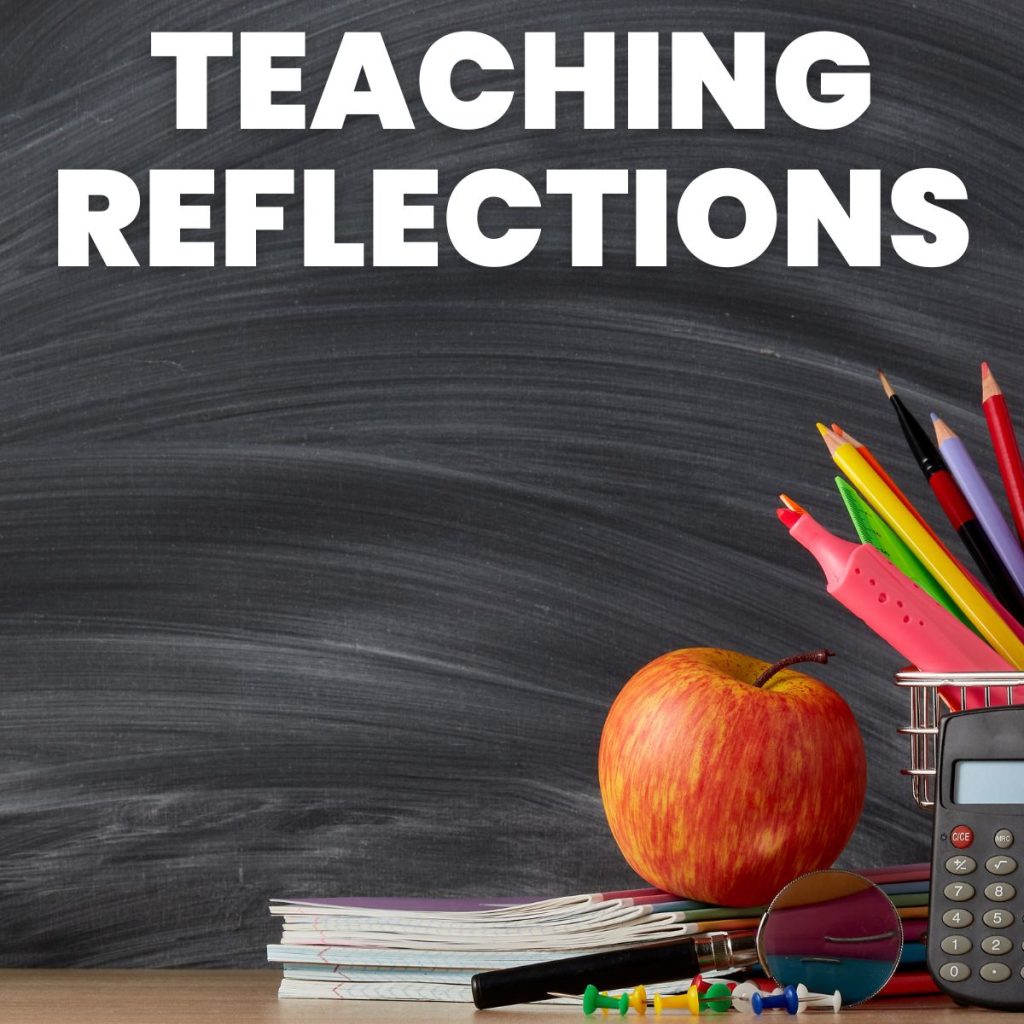
June 13, 2019 – Summer
[Originally Included in Twelve Envelopes Puzzle Blog Post]
I’ve finally reached a point in the summer where my brain has started thinking about ideas for the new school year. Actually, I’ve been thinking about next year since around February or March, but I’ve finally stopped *just* thinking about next year and started creating resources.
It’s been a number of months since I’ve had a chance to just sit down and create resources without any time pressure, and I’ve forgotten how rewarding the process can be.
Two days ago, I created a Google Classroom Poster. This past year was my first year in a 1:1 environment and my first year using Google Classroom. Every time I got a new student this past year or had a student switch from one period to another, I had to remember to go and look up the Google Classroom code so they could join the class to get assignments and announcements.
I can’t tell you how many times I had to drop everything and look up a code for a student at an inopportune time. This next year, I will be posting the codes on a poster so that I can point students to the poster whenever a classroom code is needed.
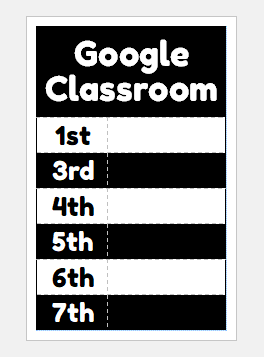
Yesterday, I started working on my plans for the first day of school. Last year, I had my favorite first day ever with the Twos to Nines Challenges. I absolutely loved being able to engage my students in mathematical thinking and problem solving from Day 1. Listening to their conversations gave me great insight into my students’ attitudes toward math.
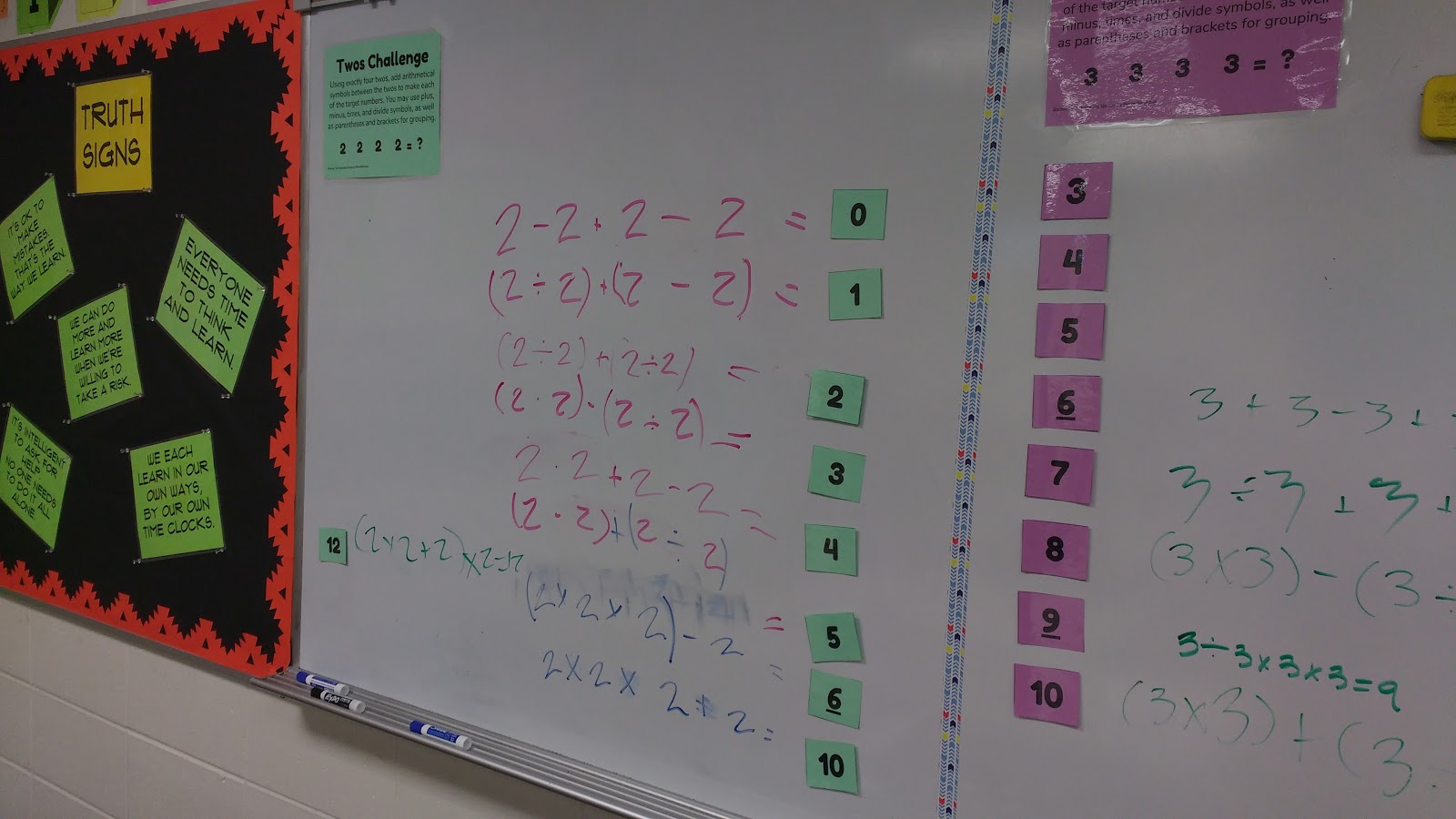
The activity went so well that I would be tempted to do the same activity again this year, but half of my classes will be made up of students who I taught this year. Next year, I will be teaching 3 sections of Trig/Pre-Calculus (students I taught this past year in Algebra 2) and 3 sections of Algebra 2 (students I have never taught before). This calls for a new first day of school math task.
This puzzle was originally published in the Giant Book of Hard-to-Solve Mind Puzzles which I was able to pick up for the bargain price of $2 at a local Goodwill.
Unfortunately, it’s currently out of print, but you can still pick up a few used copies for relatively cheap on Amazon.
In this book, I ran across a puzzle involving twelve envelopes. I posed the problem to my husband, and we reasoned through it together. We arrived at a lovely, unique solution, and I decided that it would make the perfect puzzle for this year’s first day of school.
I appreciate the fact that this puzzle is solveable with only basic arithmetic. It’s an interesting puzzle but not so complicated that it should take our entire 50 minute class period. After all, I still need to leave myself time on the first day to take roll, go over basic syllabus information (particularly the supplies that students will need to purchase), answer student questions, and take care of the sort of housekeeping items that always seem to pop up during the first week of school.
Yesterday I typed up the twelve envelopes puzzle and sent out a quick tweet about it. I’ve been absolutely blown away by the number of likes and retweets, so I figured I should blog about the activity now instead of waiting until after school starts in August.
July 17, 2019 – Algebra 2 Excitement
This coming school year, I will be teaching the same courses as this past year: Algebra 2 and Pre-Calculus. My school adopted new textbooks this past year shortly before I was hired, and our Algebra 2 books turned out to be a bit of a disappointment. Even though they were marketed to the district as being aligned to the Oklahoma Academic Standards, they were pretty much Common Core textbooks with all mentions of Common Core removed from the pages. Some Oklahoma standards were not addressed in the book at all, and the book had at least four chapters of material that did not match our standards at all. Don’t get me wrong. There were some things the book did well, and I was definitely a fan of many of the higher order thinking questions included in every section. But, teaching from the book itself was just a continual frustration.
This was my first time teaching Algebra 2 since Oklahoma rejected Common Core and decided to write their own standards a few years back. I did teach Algebra 2 during my first four years of teaching, but these years were spent teaching to a different set of standards. I dedicated my year to pretty much teaching to the test since my students were required to pass a certain number of end of instruction exams to graduate. Now that the testing requirement is gone and I know better, I want to do better by my students.
My sweet husband who is currently working on his Masters in Applied Mathematics listened to my complaints for the entire school year. He spent two years teaching Algebra 2 with the new Oklahoma standards prior to taking a break to pursue grad school, so he had plenty of his own ideas about how an Algebra 2 class should be structured. In April, after he finished with his finals, he started a monumental task of writing his own collection of Algebra 2 notes that would be directly correlated to the Oklahoma Academic Standards. It’s been so hard for me to keep my mouth shut about what he’s been doing because I’ve been so excited. But, this was his work, and I knew he would share it when he was ready.
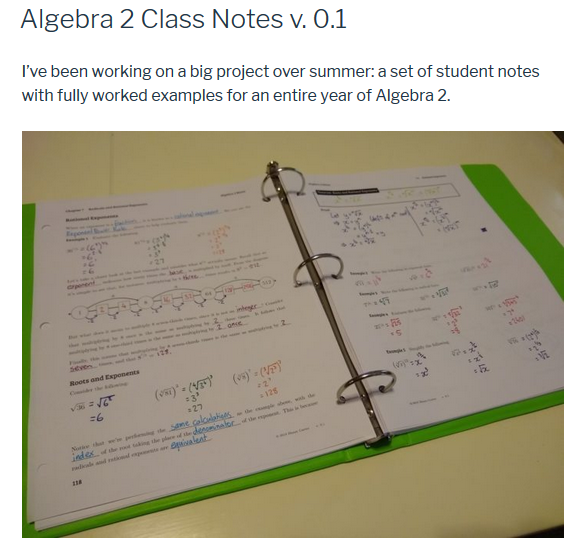
Yesterday, Shaun pressed publish on 184 pages of Algebra 2 notes. And, I couldn’t be more proud of him. Even though, the notes are written for the Oklahoma Standards, there are plenty of takeaways for teachers in any state or country. I highly recommend taking a look at the answer key version of the notes to understand just how amazing of a resource that they are. (If you want to be even more impressed, consider the fact that he wrote the bulk of these notes when our now 2.5 month old was a newborn!)
Here are some of my favorite pages. I’m sure I’ll find even more favorites as I start using them in my classroom in less than a month. (Where did summer go?!?)
I have to mention the beautiful dedication he wrote. It definitely made me tear up when I read it!

Now, on to my favorite pages!
I love using the box method with my Algebra 2 students. These notes are FULL of the box method. I’m so glad I won’t have to answer endless questions about what FOIL is because my students saw it mentioned in the text…

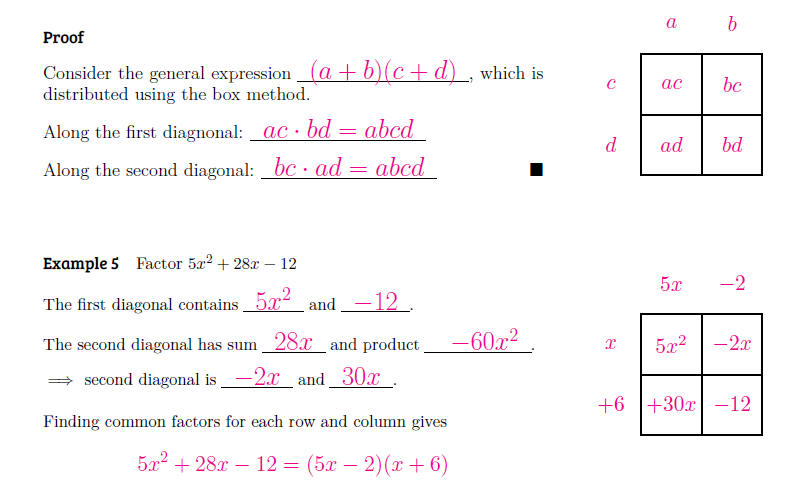

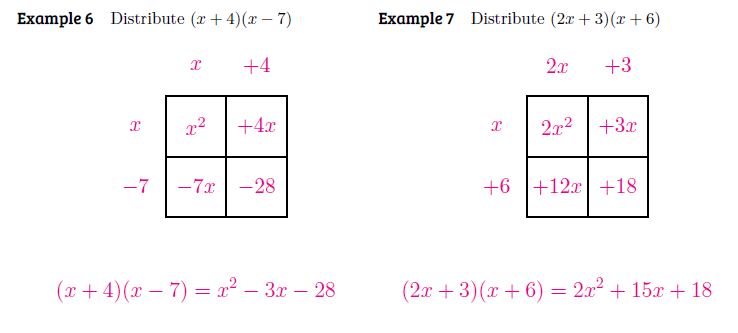
This is the most amazing visual I’ve ever seen for explaining how to use the box method for dividing polynomials!
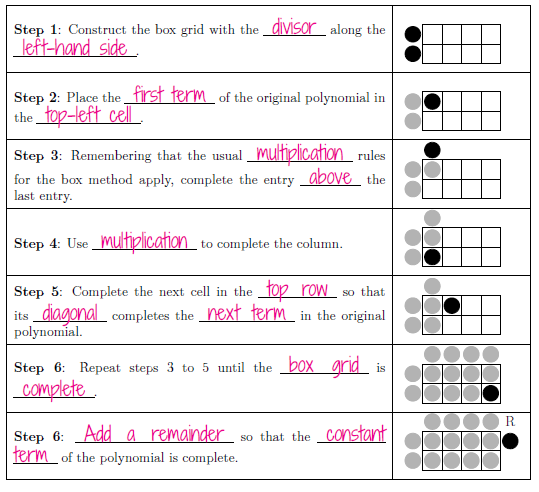
There are tons of opportunities for color-coding!
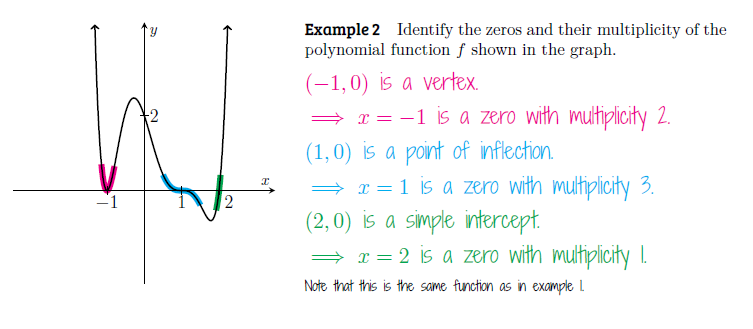
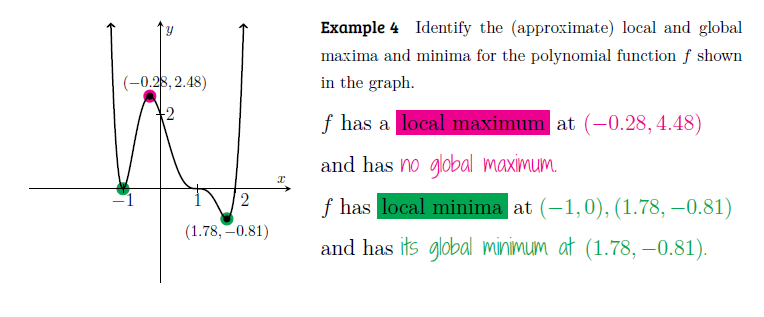
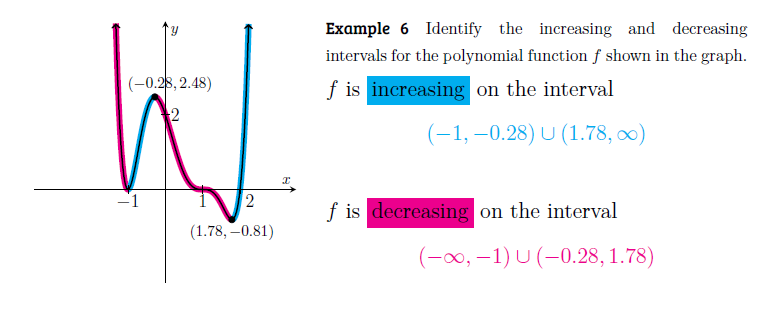
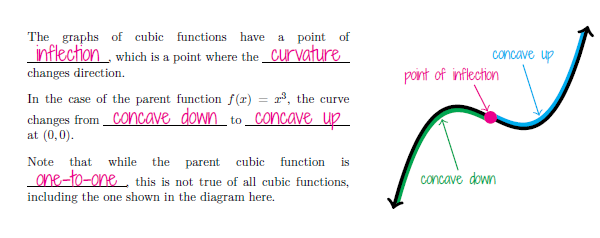
Shaun put a ton of time and effort into making sure his graphs were precise. This was one of my complaints about the textbook I used last year. I assigned my students a problem involving writing an equation for a graphed parabola only to realize when students started arriving at different answers that the graph wasn’t even a true parabola!
These graphs on this correlation coefficient number line have exactly -1, -0.5, 0, 0.5, and 1 as their correlation coefficients. This is what I mean when I say that there are resources in this book that can be used by anyone, no matter your standards. Open up the blank note-taking document, use the snipping tool to capture the image of the blank number line and graphs, and put it in your own document (with proper attribution of course!).
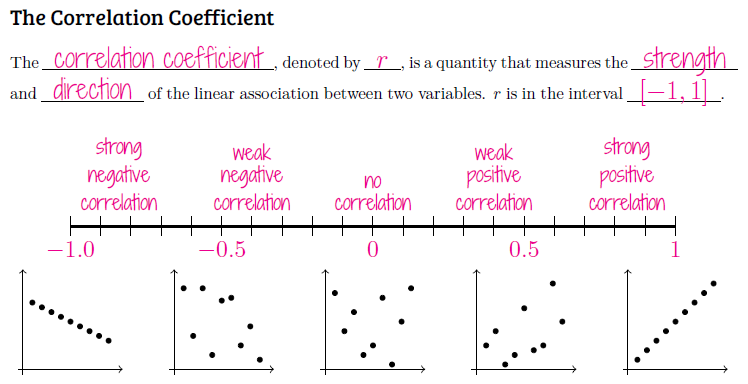
Check out this gorgeous graphic organizer for converting between different forms of quadratics.
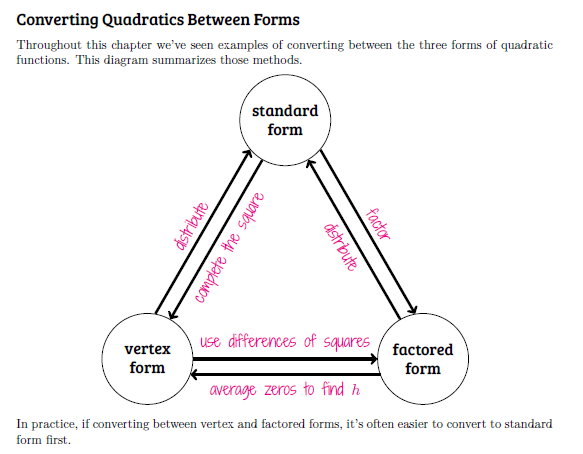
Beautiful graphs grace so many of the pages of these notes.
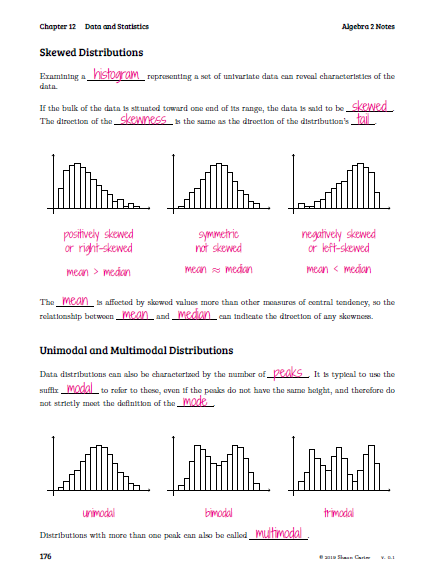
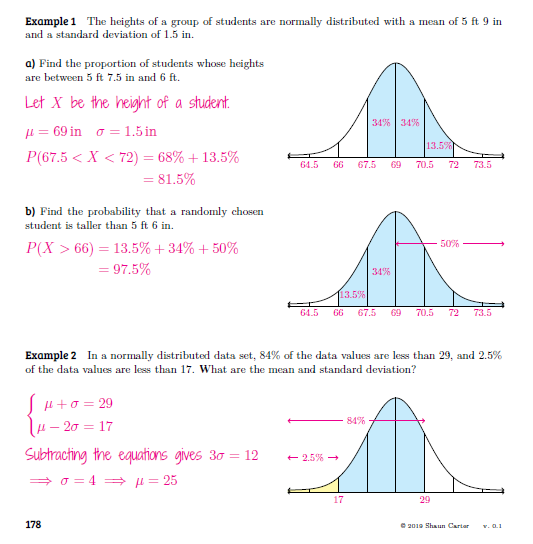
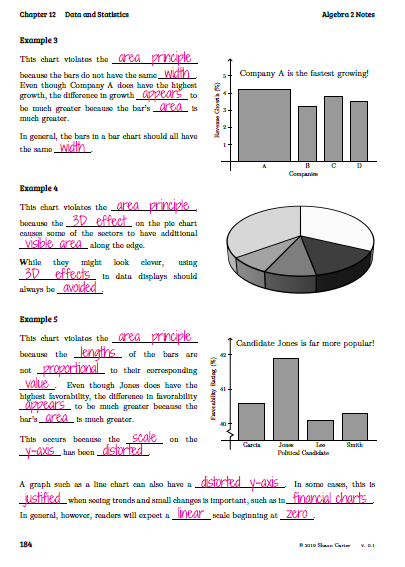
I’m super excited about how the notes address parent functions since the study of functions really does sum up what Algebra 2 is all about. Here are the parent functions addressed by the notes:

Each time a new parent function is introduced, a number line, graph, and table are included in the notes. These will be the perfect reference for students to return to time and time again!
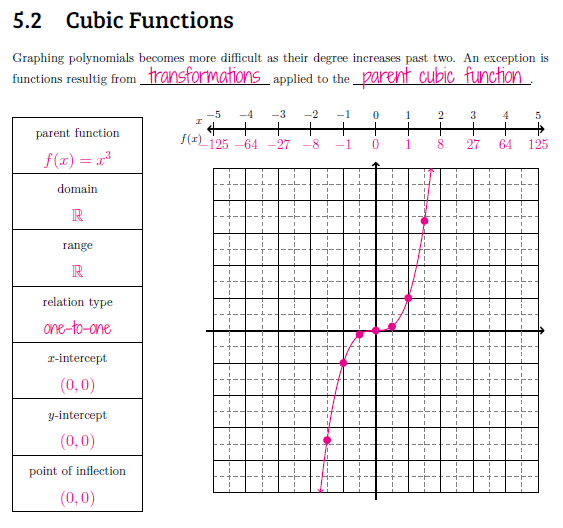
There is a definite emphasis on proof throughout the course. I especially like this fill-in-the-blank derivation of the quadratic formula.
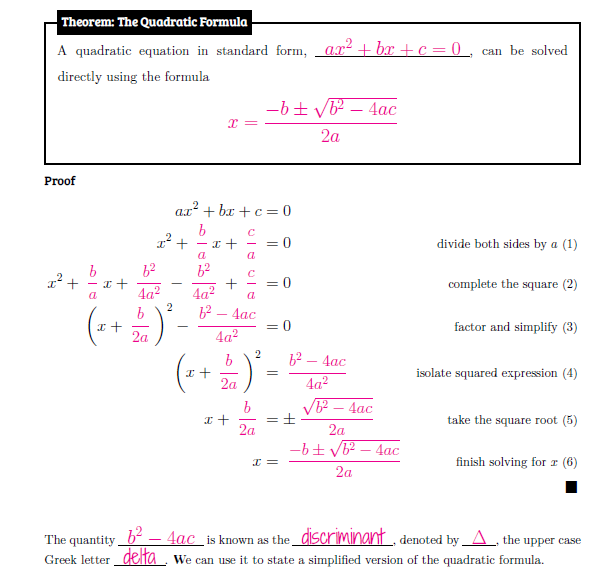
A visual explanation of rational exponents!
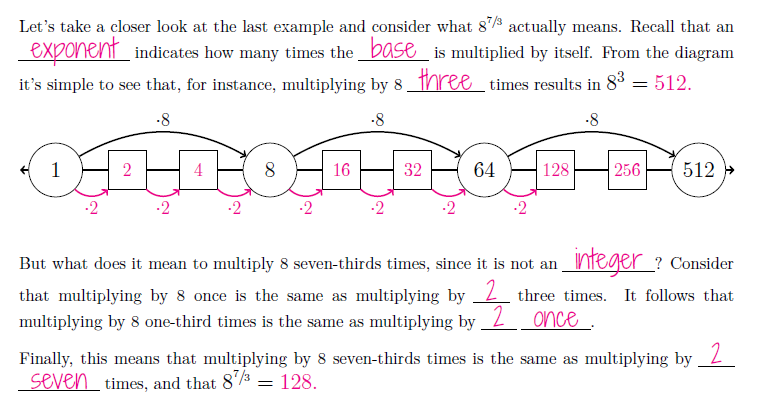
And so many organized tables for students to complete and use as a reference later on!
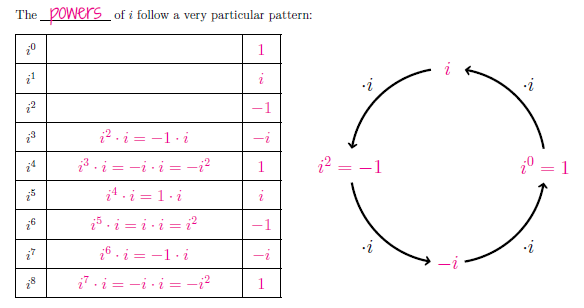
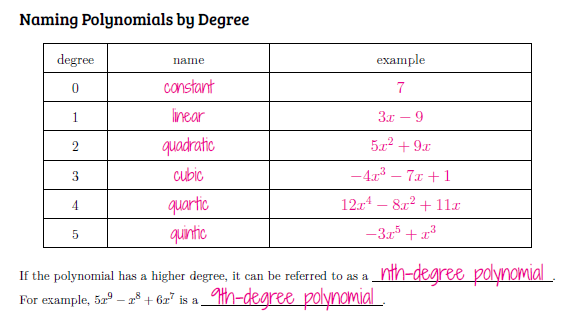
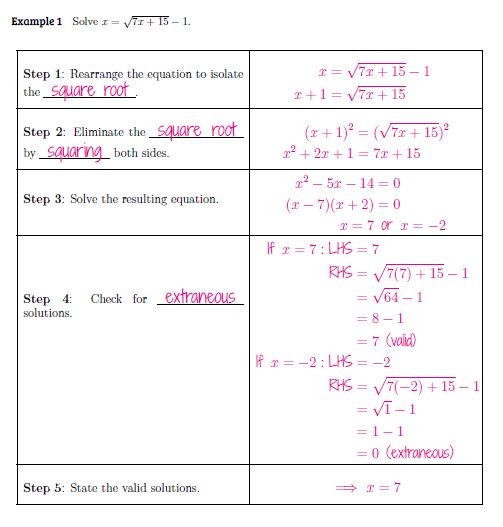
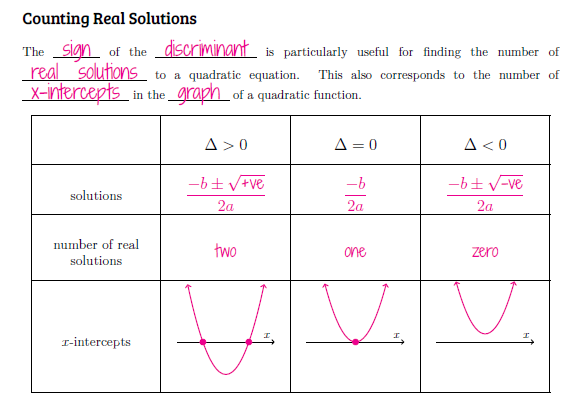
What really blows my mind is that this is just a fraction of the 184 pages! Do keep in mind, that this is still in draft form. More changes will be made as the summer progresses, and I’m sure I’ll have a list of new changes I want made once I start teaching through this curriculum this school year. I’m super excited to see what this grows into. I look forward to sharing more favorites I discover as the year progresses!
So, do yourself a favor and take a look at these amazing Algebra 2 notes or forward them to someone who might need a free resource to use in their classroom!
September 29, 2019 – Tangram Challenge Binder
This school year, I’m taking two approaches to incorporating puzzles into my classroom on a regular basis. Every Monday, I put a new magnetic puzzle up on the dry erase board. For example, last week we tackled the Domino Effect Puzzle.

I also have a table that I have designated as the “Puzzle Table.” These puzzles tend to be more hands-on puzzles with lots of different challenges using the same set of hands-on pieces.
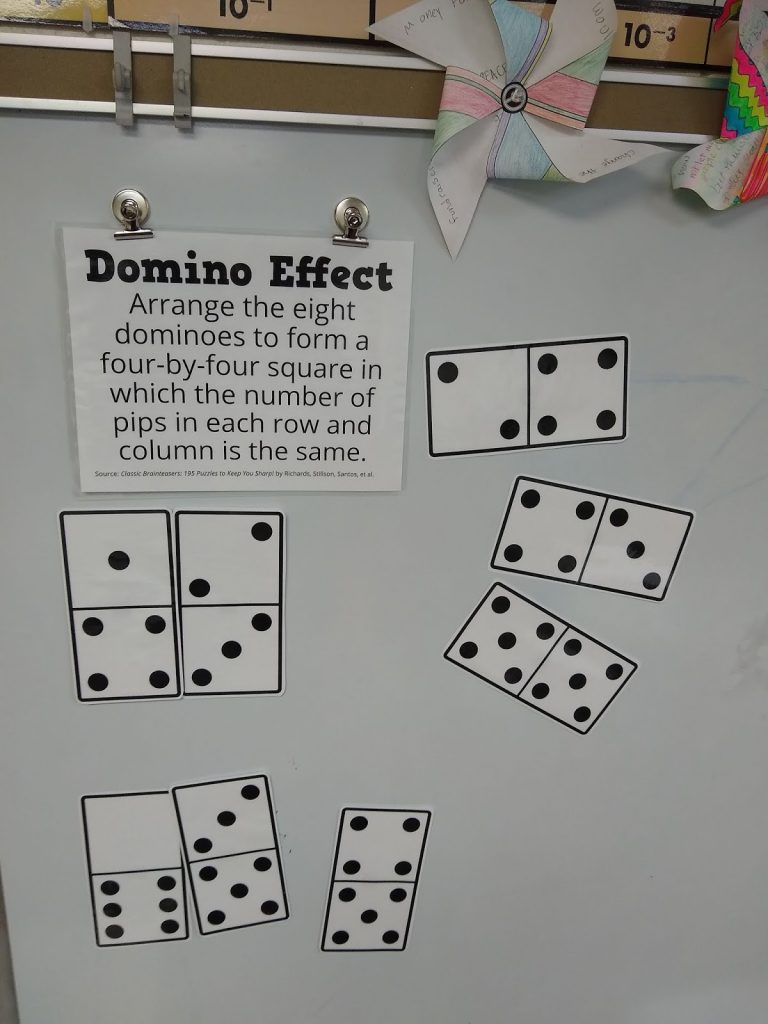
For the first month and a half of school, my students really enjoyed the SOMA Challenges I shared about this past summer.
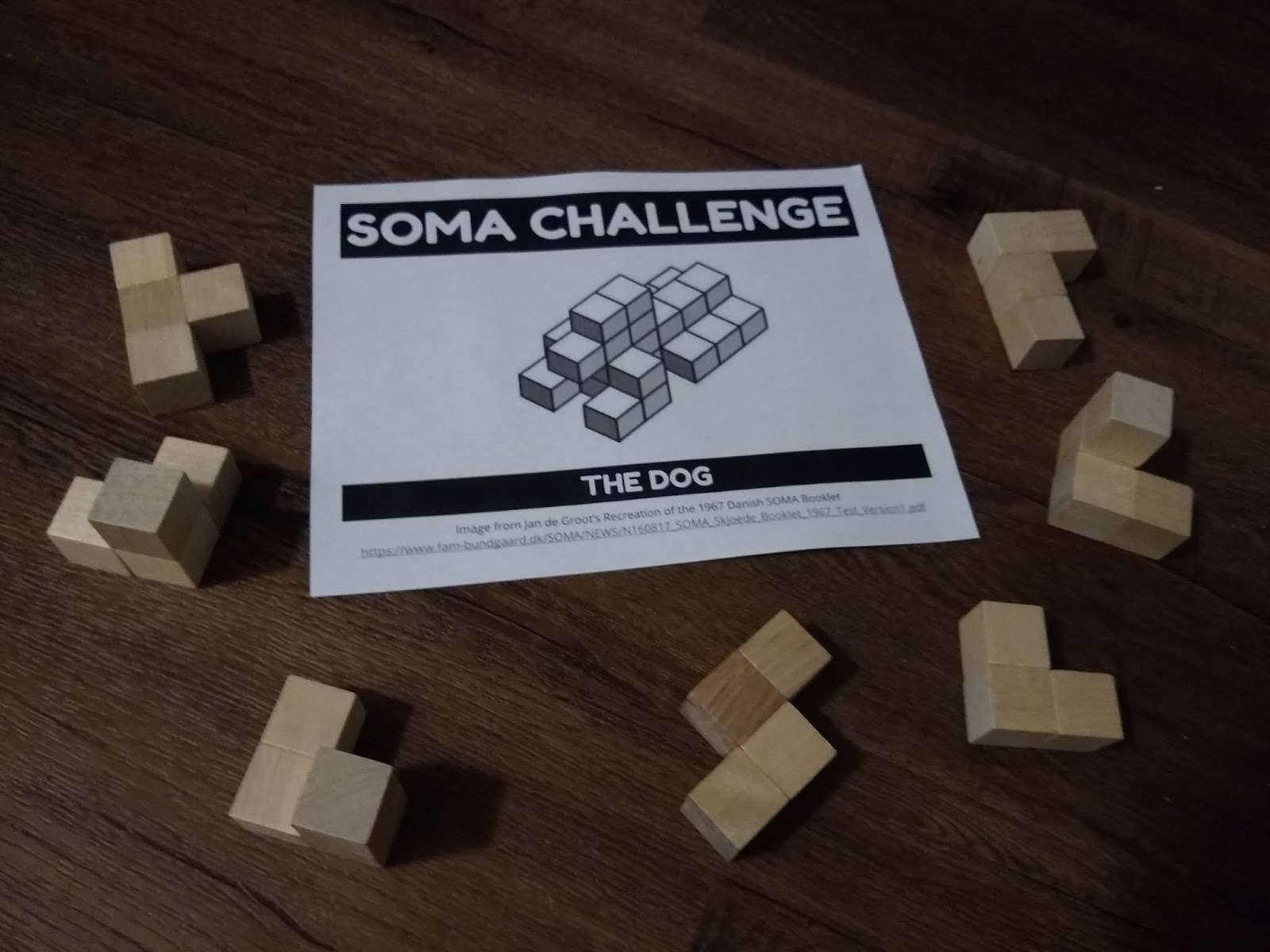
This week, the SOMA blocks are going back in the cabinet and being traded out for TANGRAMS!
After my first year of teaching, I invested in a class set of tangrams. I love using tangrams as a growth mindset puzzle at the beginning of the year by asking students to create a square using all 7 tangrams.
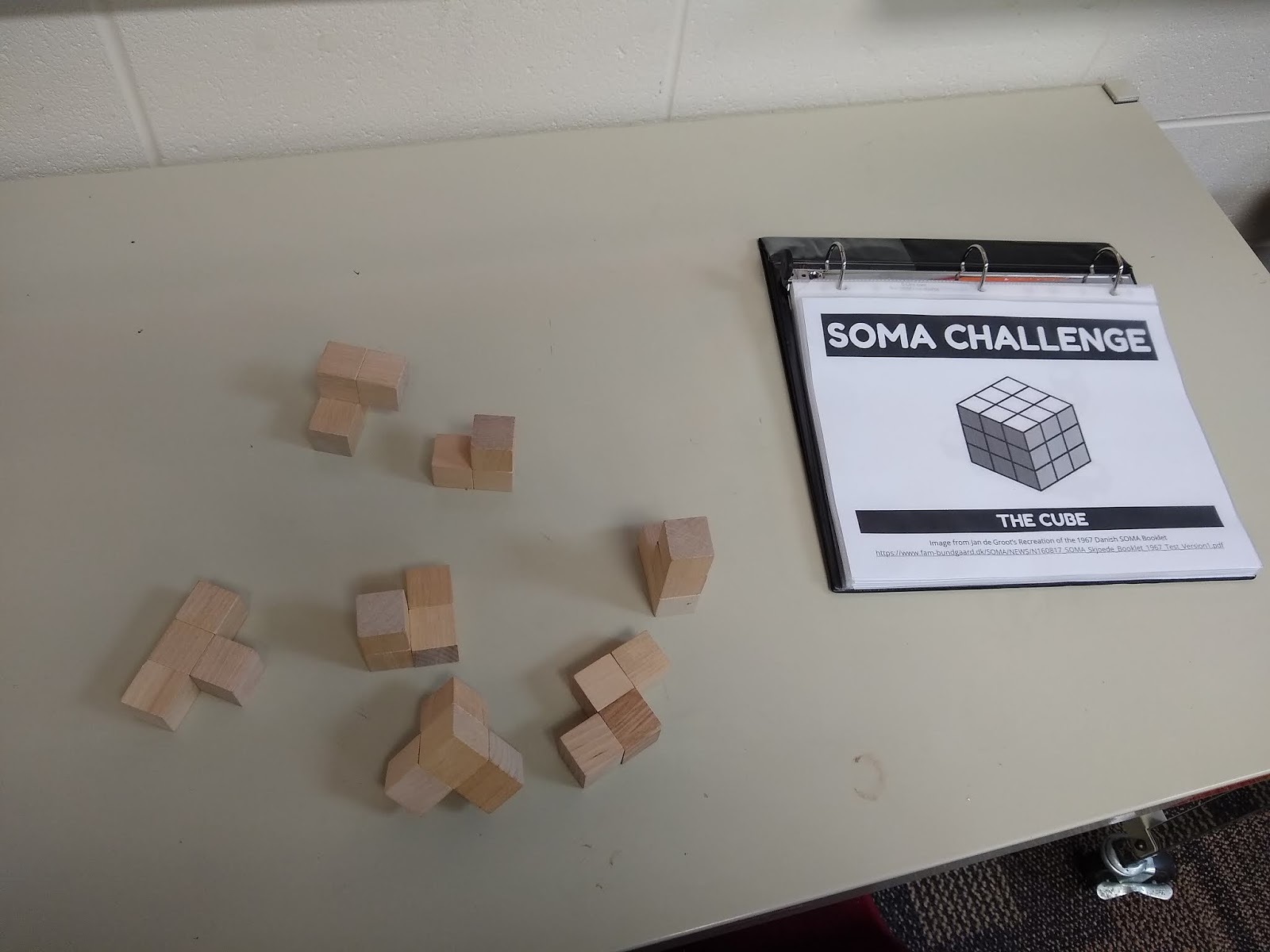
With the SOMA Challenges, my students really enjoyed being able to flip through the binder of puzzles and choose a challenge to work on. I decided to give my students a binder full of tangram puzzles to work on.
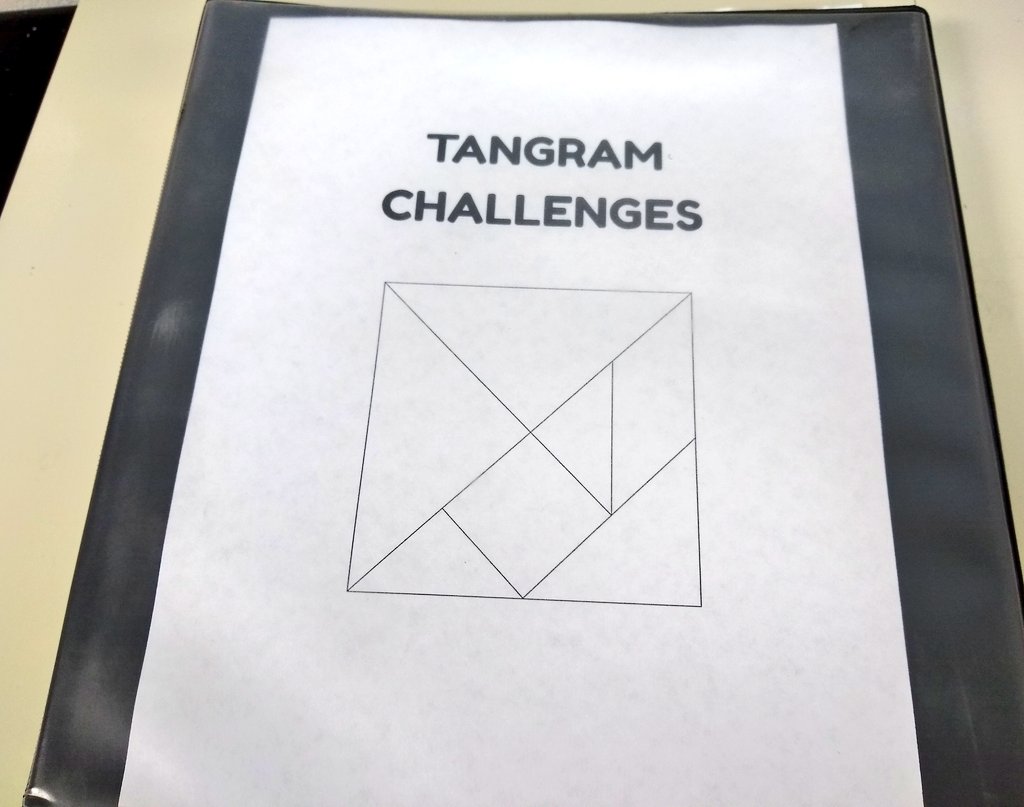
I got the tangram pictures from my favorite clipart website – Clipart ETC. The website is chock-full of educational clipart that can be used by teachers 100% for FREE. My most-used section of their website is their collection of coordinate plane clipart.
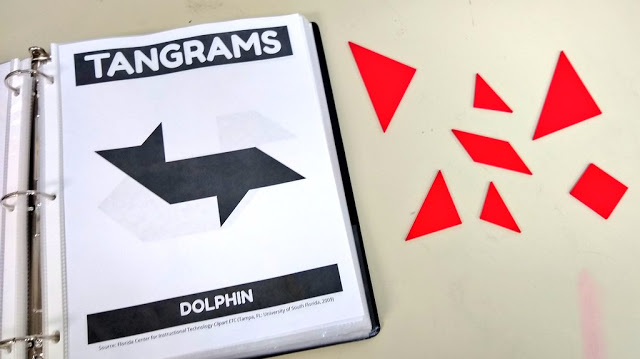
They have an entire section of Tangram Puzzle Clipart that made putting together this binder super easy.
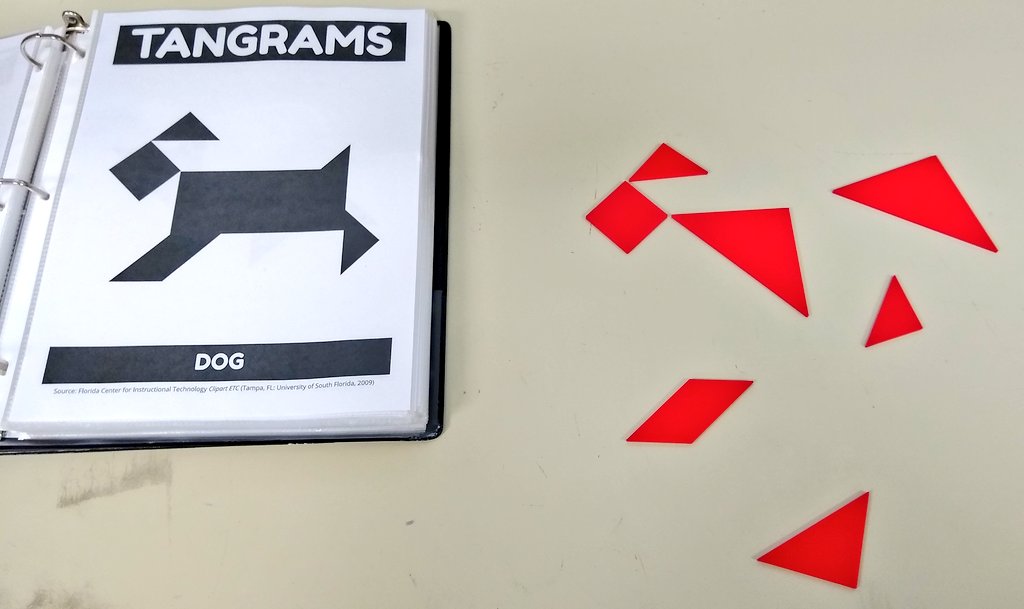
I love that there is a great variety of images. Hopefully, my students will all be able to find some tangram puzzles that capture their interest.
There are 97 different challenges which should keep my students busy for a very long while.
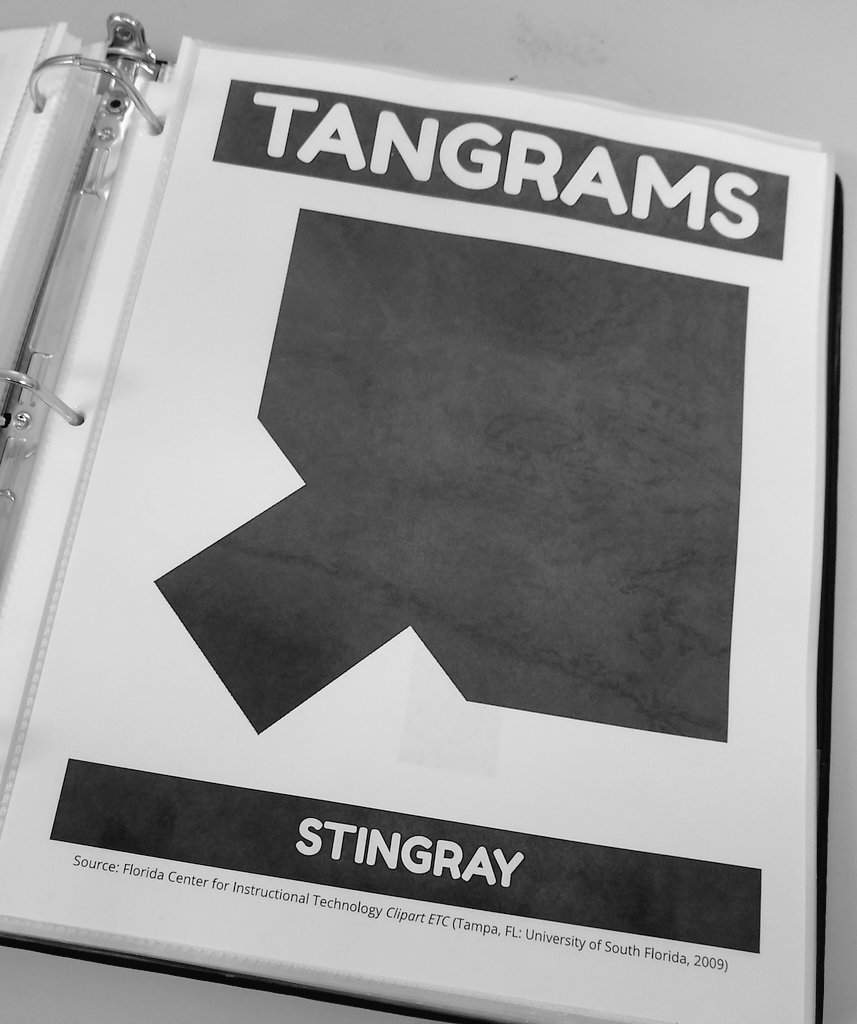
If you don’t want to put out all the challenges at once, you could also put one up each day/week/etc with magnets.
To save you the work of copying and pasting the tangram clipart yourself, I’ve decided to share the PDF file of free printable tangram puzzle challenges with you.
April 1, 2020 – 2019’s Most Popular Posts
I started this post back in early December. I put off finishing it until closer to the end of 2019. Then, we took a whirlwind trip to Australia (including six flights with an infant) over Christmas Break. I’d started to think that I was never going to have time to finish this post. I guess you could say I didn’t see this worldwide pandemic coming…
So, as I now have time to blog again, I guess it’s fitting to take a look at last year’s top ten posts to see what types of posts you guys actually like to read. Here are my top ten posts according to popularity of pageviews. Maybe you’ll run across a post you somehow missed in 2019!
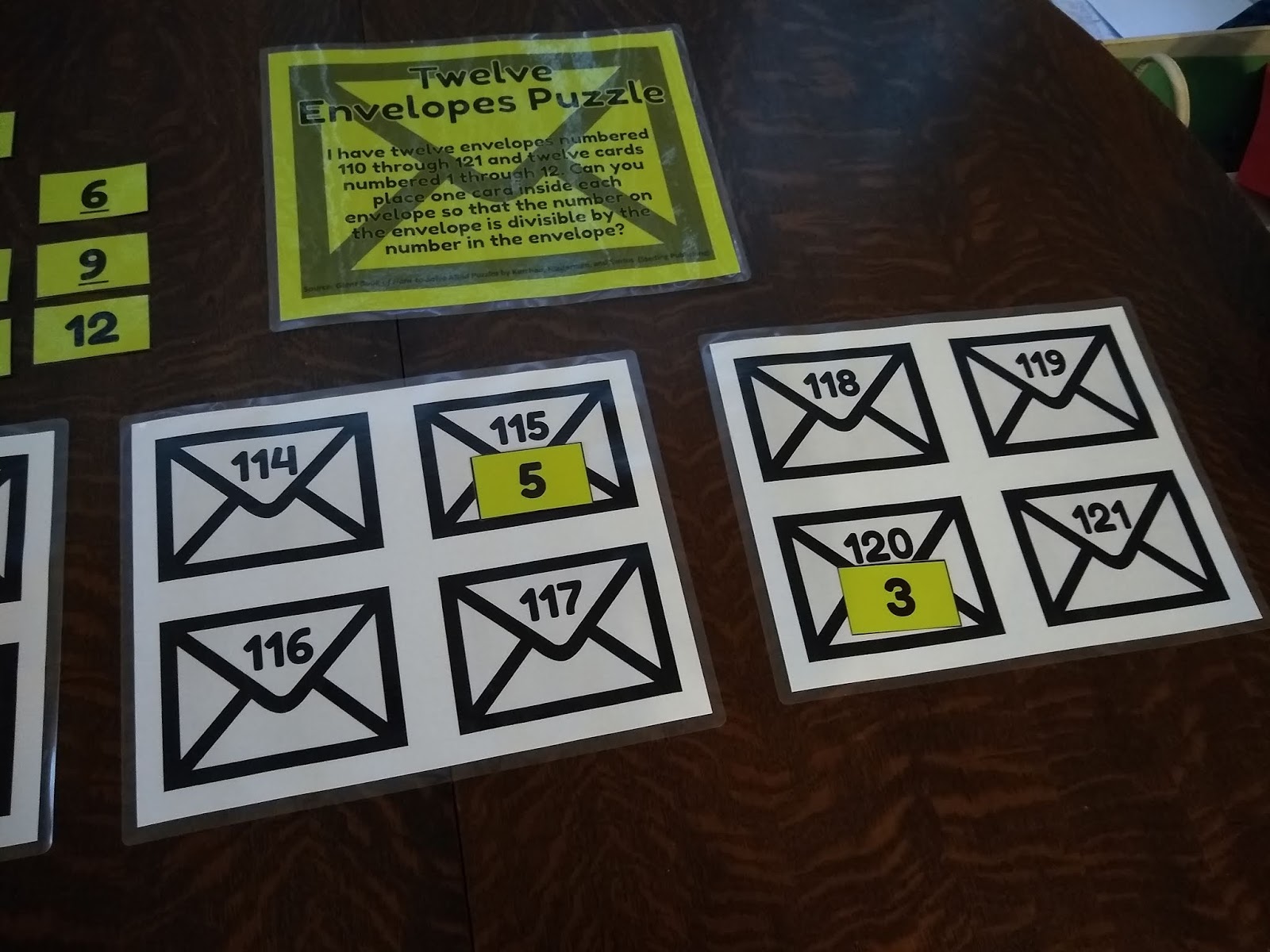
I guess it’s no huge surprise that my first day of school activity was my post popular post of the year. 2018’s First Day of School Post (2s to 9s Challenge) was my second most popular post of that year. It helps that Oklahoma goes back to school before a large chunk of the rest of the country. And, my blog views always seem to peak around the beginning of the school year. I guess it’s time to start thinking about how I’ll start off next school year when I hopefully get to see my students in person again!
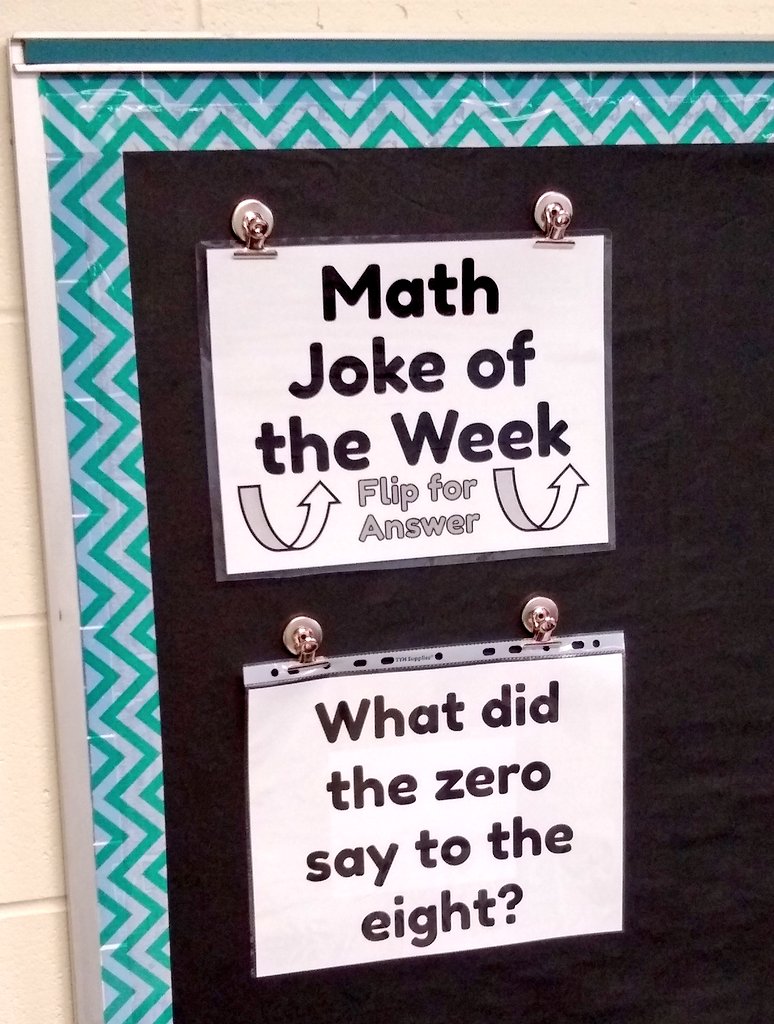
You guys were just as excited by the idea of a math joke of the week as I was! It turns out my students really loved it, too. They were quick to remind me whenever I forgot to change the week’s joke. Usually, one student in a class period would notice the new joke, read the joke aloud to the class, and then flip up the joke to reveal the answer with great fanfare. It was a beautiful sight to see.
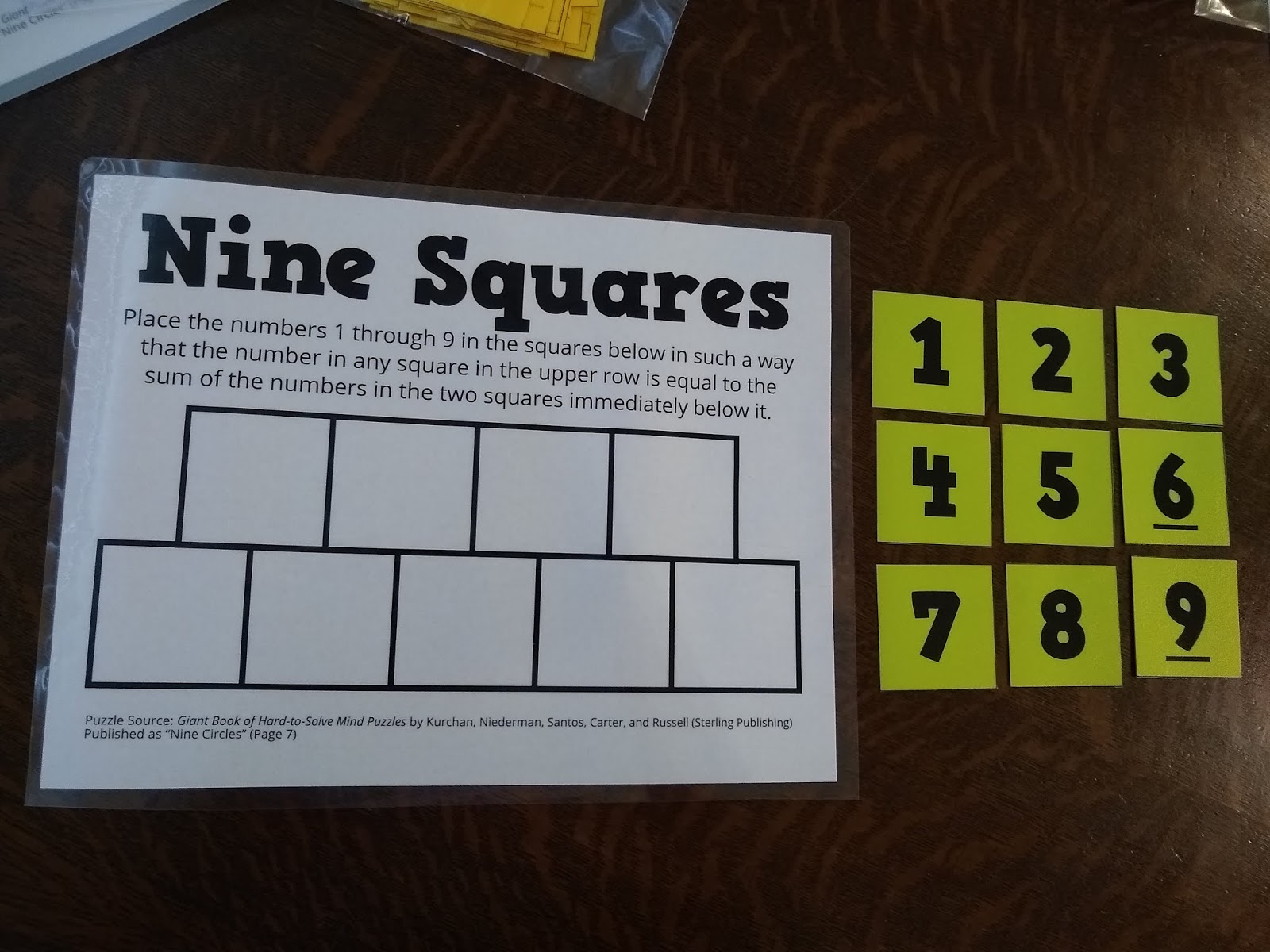
This puzzle was super popular on both my blog and twitter. I love seeing the photos of everyone trying out this puzzle with their students!
4. Trig Identity Match-Up Activity
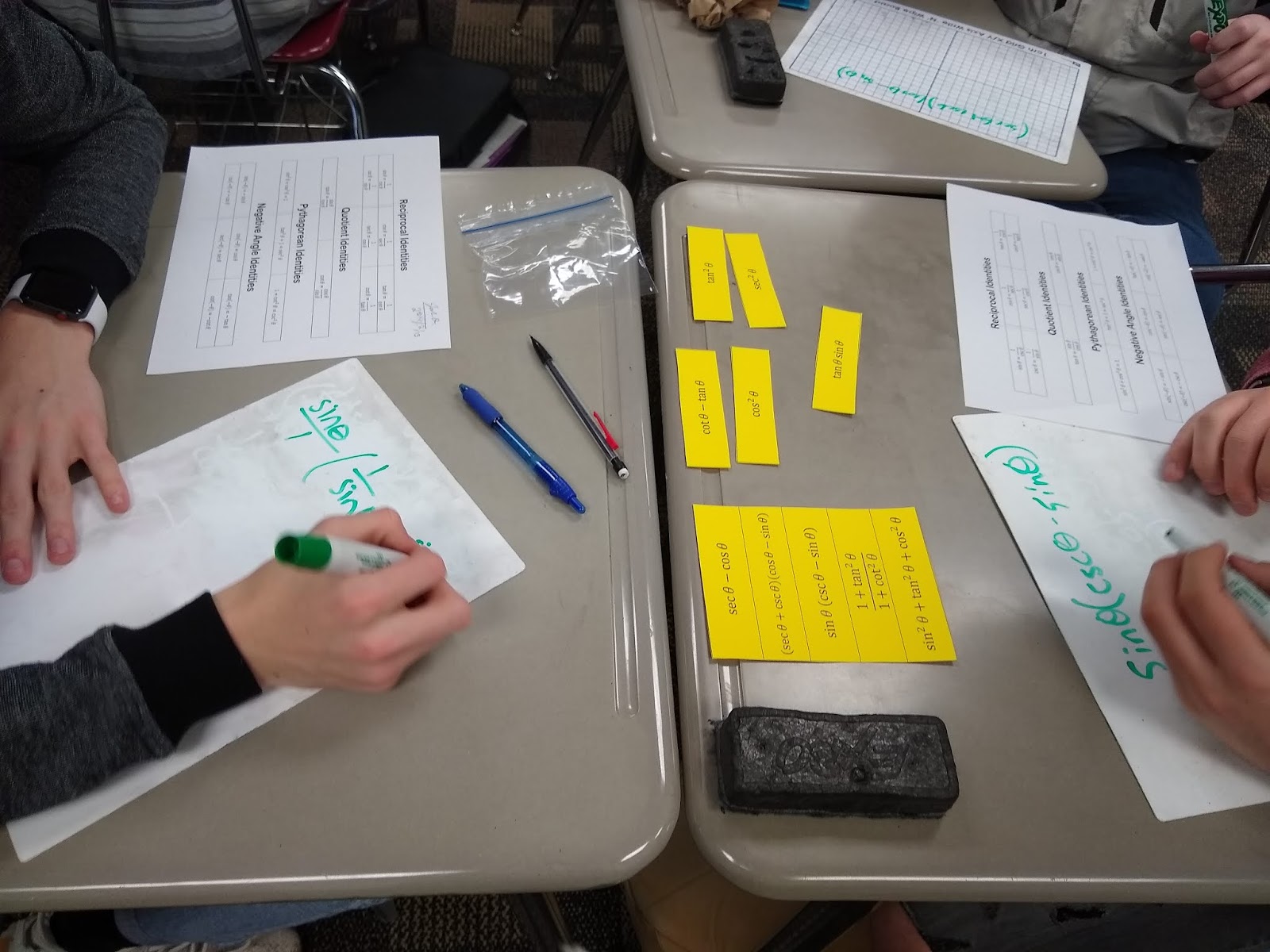
I have LOVED getting to teach Trig/Pre-Calculus each year as part of my new job teaching at my old high school. It’s been so fun getting to make new activities. This matching activity for trig identities has been one of my favorite new creations. I’m excited to see a non puzzle/classroom decoration post getting some love.
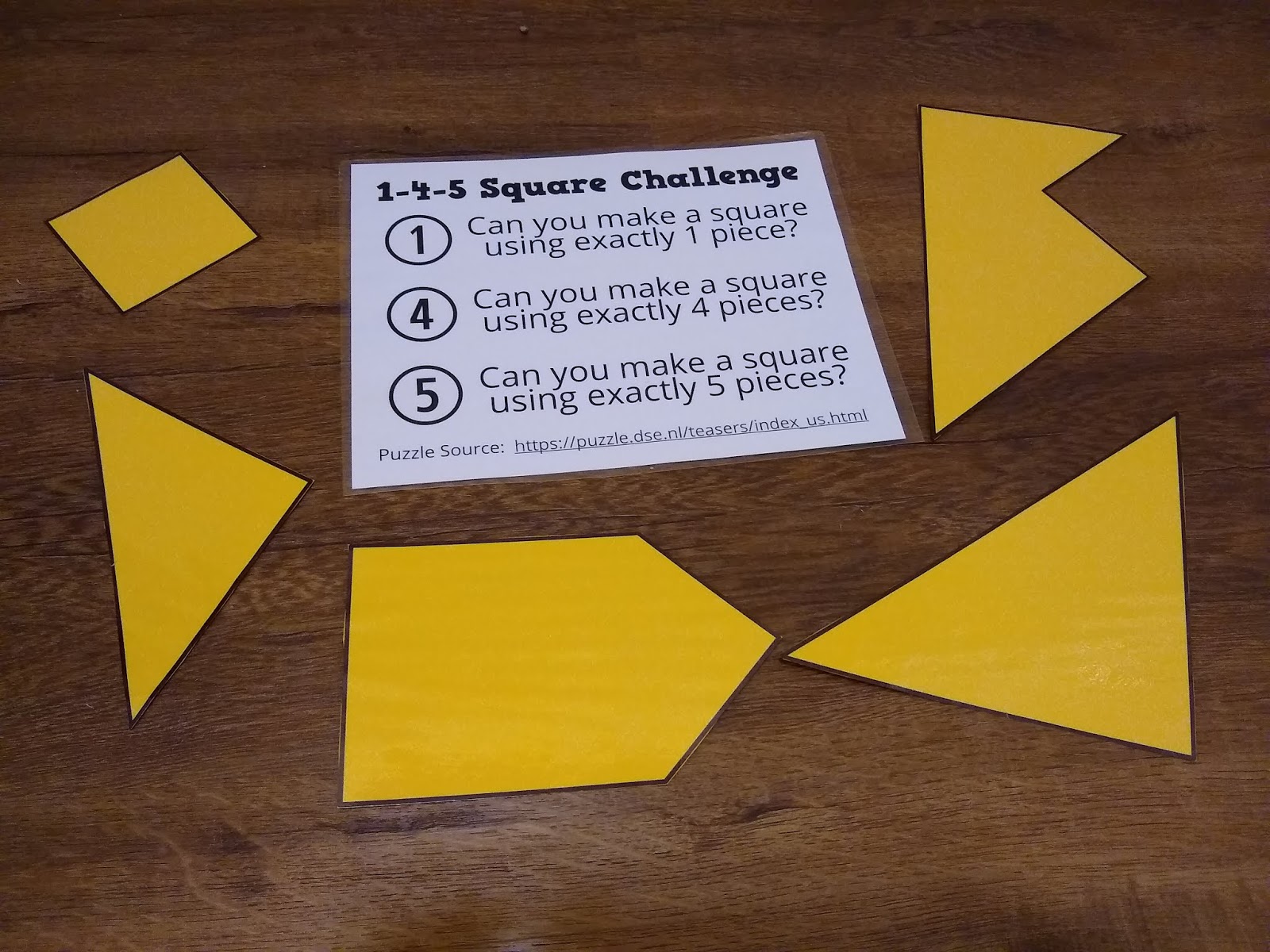
This was an updated jumbo magnetic version of a puzzle I’ve been using with my students for YEARS. This puzzle is a popular post for good reason. This is an excellent leveled puzzle that starts students off with a challenge they can’t fail and slowly ramps up the difficulty level until students are claiming the puzzle is impossible. I promise. It it isn’t!
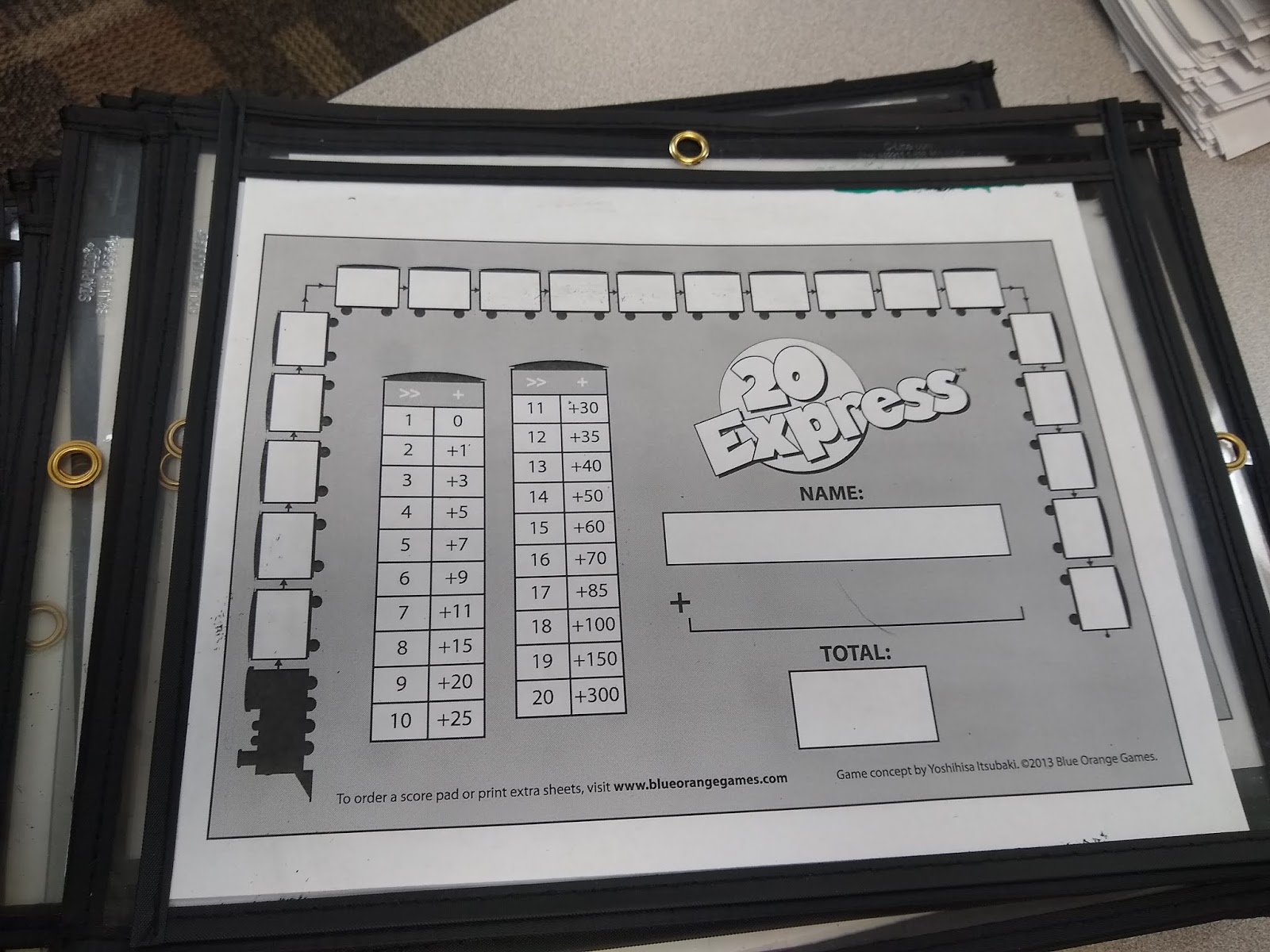
The “Train Game” is one of my very favorite games to play at the beginning of the year with my students while schedules are still settling down. It’s an easy to learn game, but it’s not always the easiest to explain to students. Hopefully, my post about how I teach the game to my students made the game accessible to many more classrooms than previously.
7. Dividing Polynomials Using the Box Method Puzzle
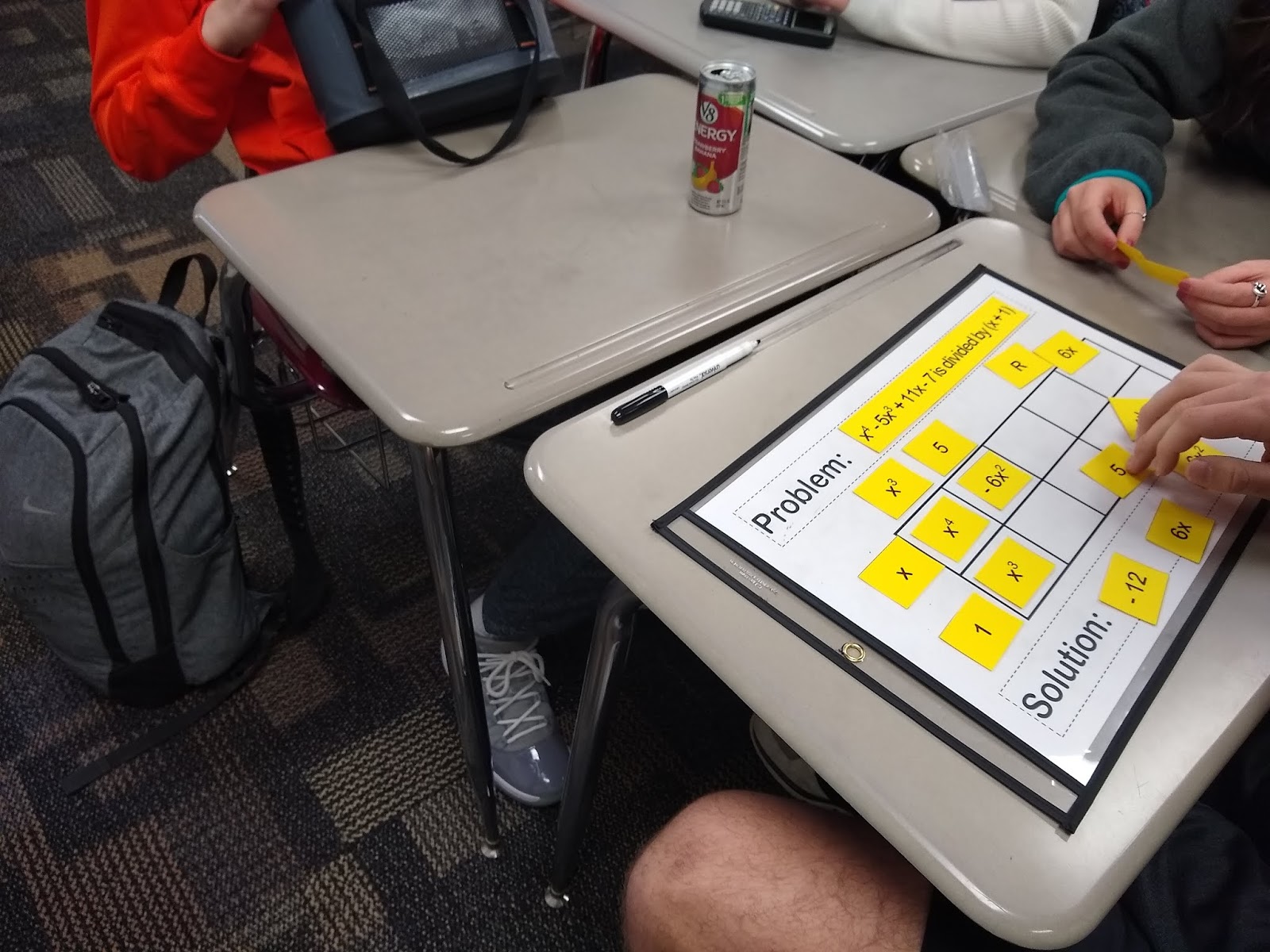
The Box Method has to be one of my favorite parts of teaching Algebra 2. I refuse to teach polynomial division any other way. I’m glad to see this post about introducing polynomial division using some puzzles getting some positive attention!
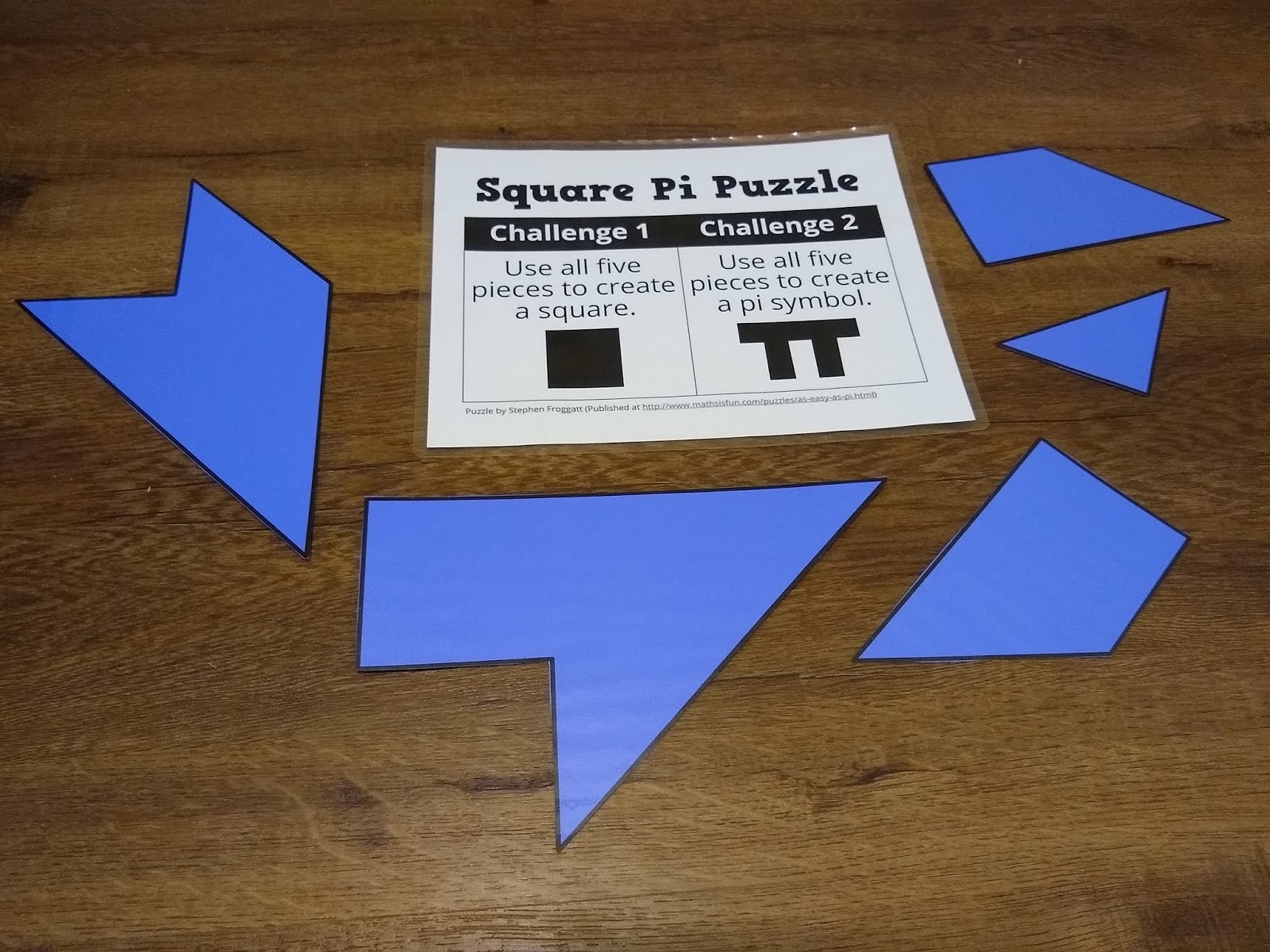
I love this Square Pi Puzzle for bringing a bit of puzzling fun to the classroom for Pi Day. Sadly, Pi Day was on a weekend this year, and the few days leading up to it were a bit overshadowed by COVID-19 news. So I didn’t actually end up celebrating it in my classroom this year. I guess I’ll have to wait until next year to pull out this always-popular puzzle.
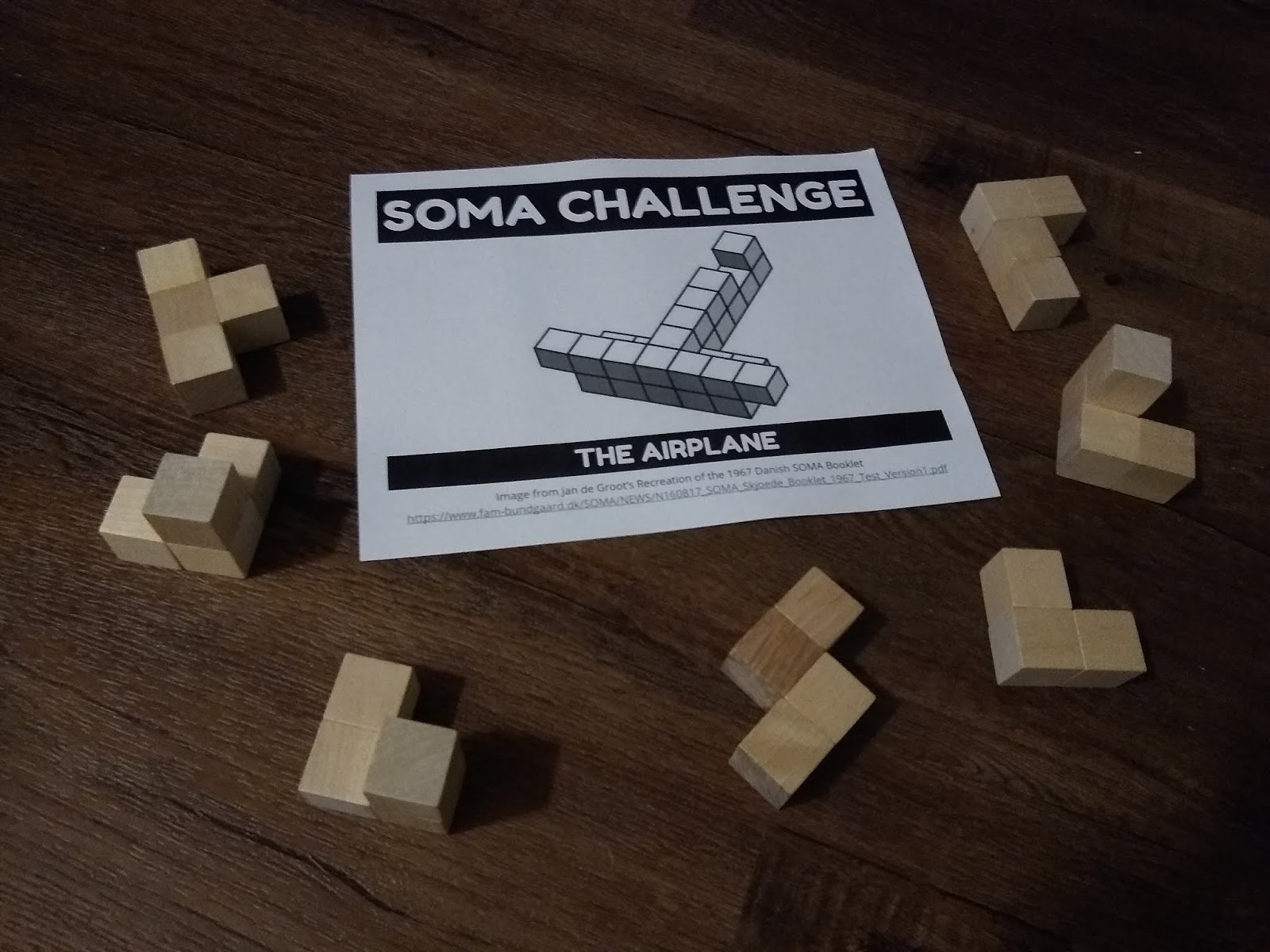
It’s exciting to see some of my summer block projects getting some blog love. These SOMA Challenges were a huge hit with my students during the first few months of the school year when I had them out on the Puzzle Table. Kids loved being able to flip through the binder of challenges and choose a new puzzle to tackle with the blocks. Plus, they were pretty fun to build out of wooden cubes!
10. Genius Blocks
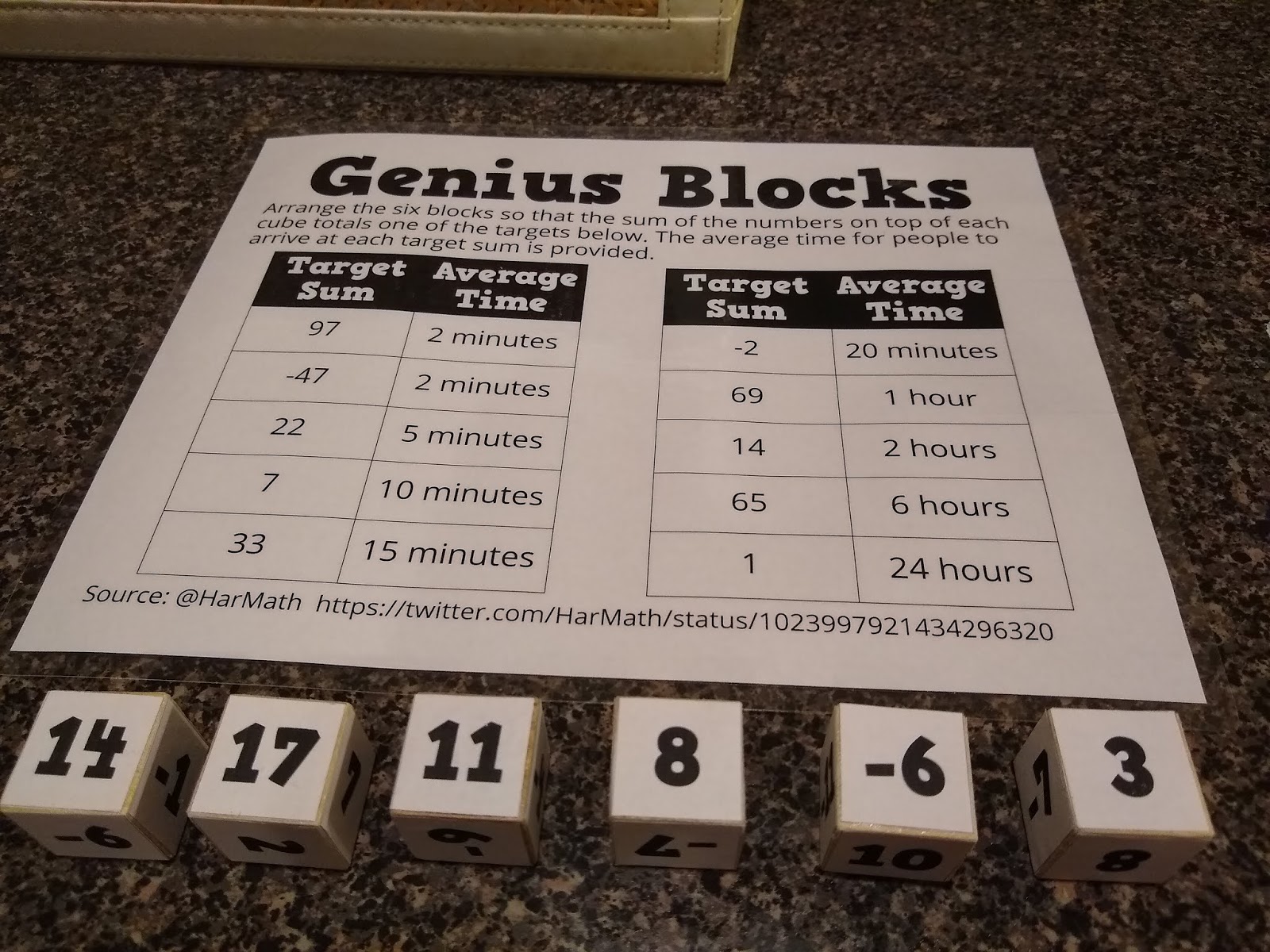
My tenth most popular post of the year was another summer block project made out of wooden cubes. I actually never got a chance to try these with my students this year. 🙁 I still really enjoyed people sending me pictures of their students tackling the genius block puzzles throughout the year.
I hope you enjoyed this look back at 2019. Here’s hoping for plenty of blogging in 2020.
April 3, 2020 – A Humorous Ten Day Syllabus for Pre-Calculus
I ran across this ten day syllabus for pre-calculus while searching for something else on google. It captured so many of the experiences I’ve had teaching Pre-Calc, that I thought I should share it on Twitter. My tweet was liked 881 times and retweeted 184 times, so I guess it resonated with a bunch of other math teachers as well.
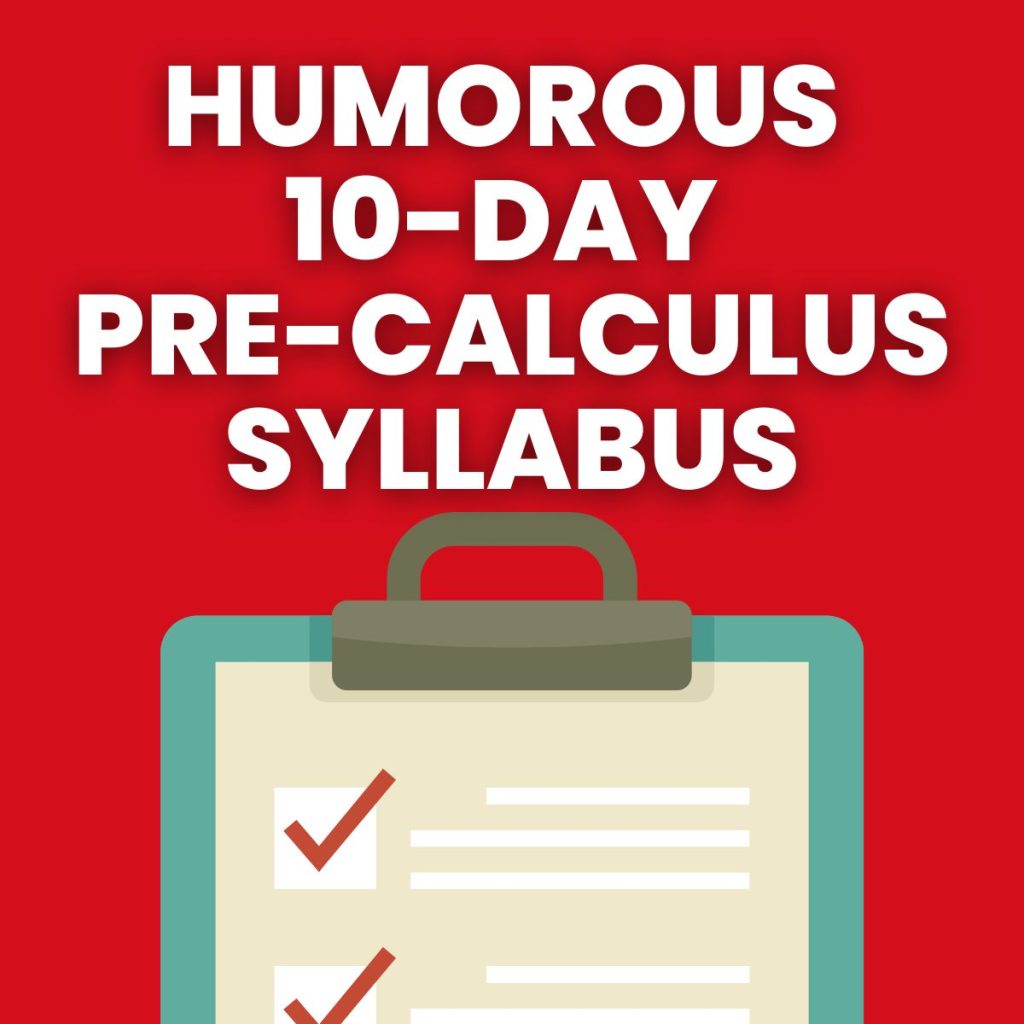
Doug Shaw commented on my tweet to say that he wrote this in 2002 and it was published in The Australian Mathematics Teacher.
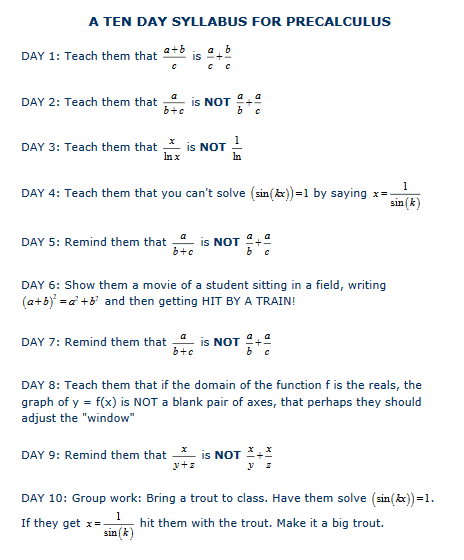
April 4, 2020 – Pollynomial
I gave this “Polly”nomial task to my Algebra 2 students. The results did not disappoint. And, it made grading a somewhat boring assignment much more interesting!

A couple of months ago, my Algebra 2 students were working on polynomials. There was ~10 minutes left at the end of class, and they were in dire need of some good old-fashioned practice. So, I had them get out a sheet of notebook paper and work out the problems I was going to write on the dry erase board.
Except there was an issue. I got to number nine, and I had asked all the different types of questions that I wanted to. But to stop at nine questions seemed weird.
I had a split second to decide whether I was going to stop at an odd nine questions or if I was going to think of a tenth question on the fly.
I chose the latter. For question 10, I asked my students to draw a picture of “Polly”nomial. I didn’t elaborate.
I just threw the question up on the board to see how my students would take it. When students asked questions, I just shrugged my shoulders and told them that I wanted to see what they would come up with.

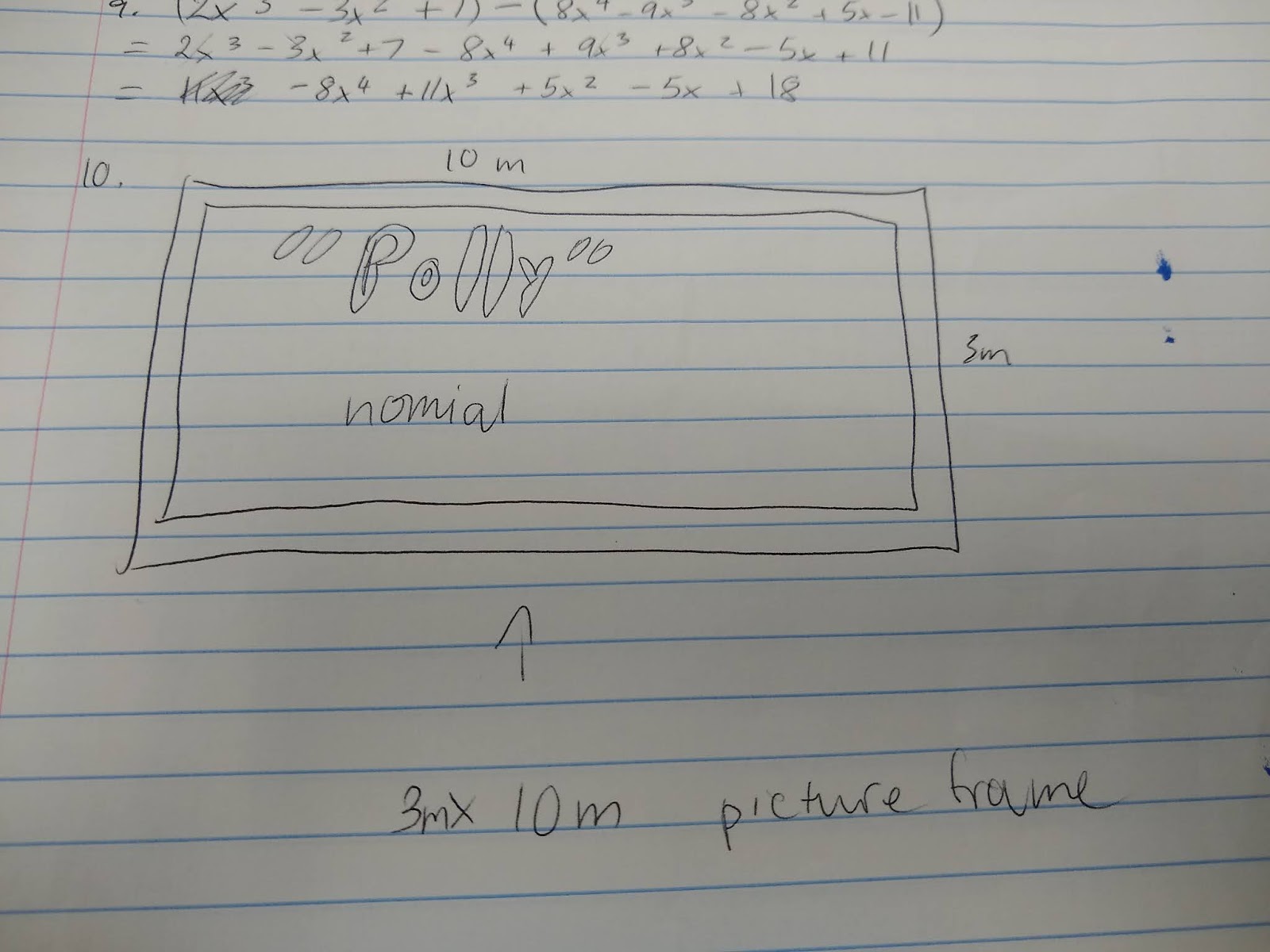
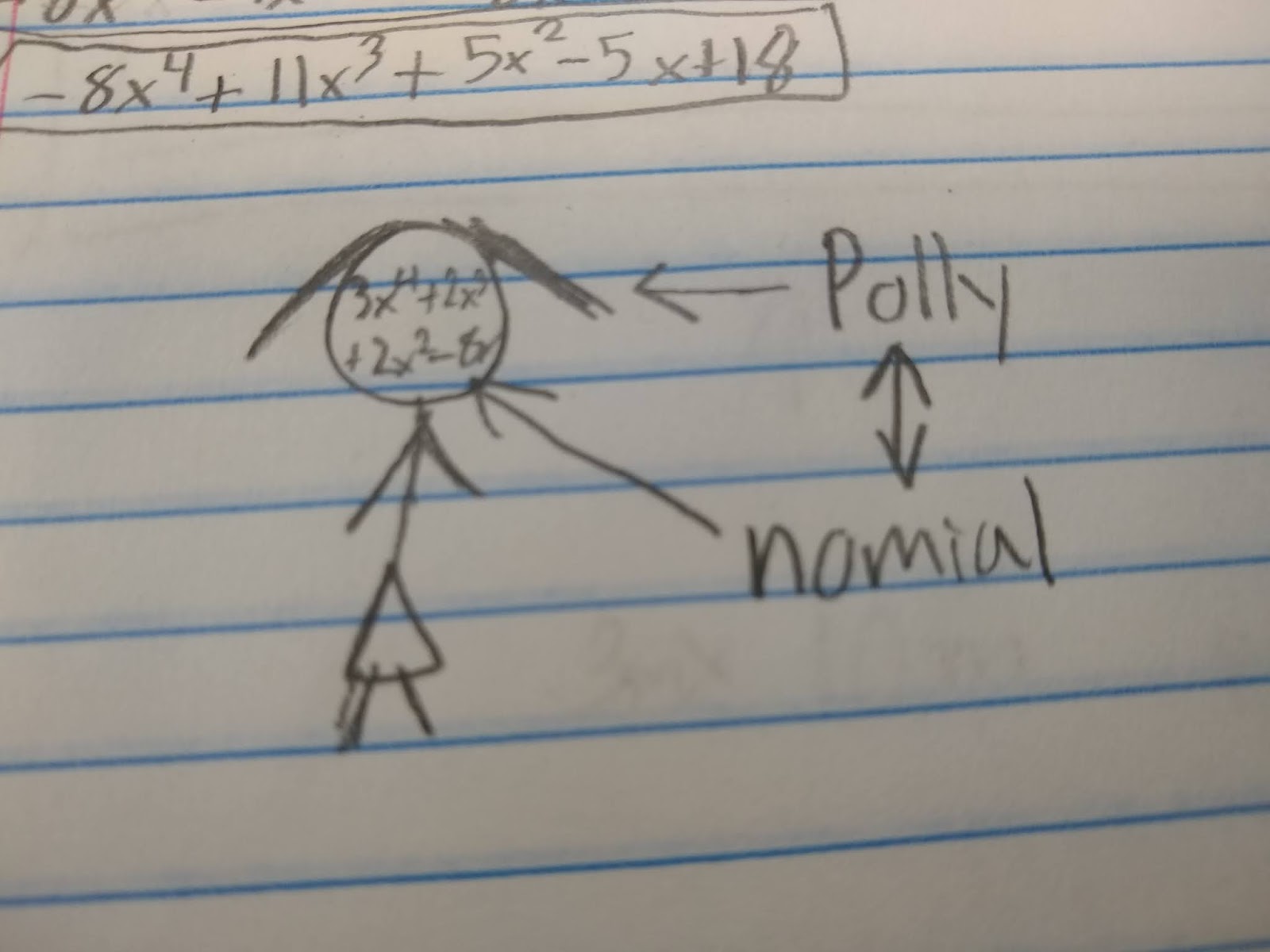
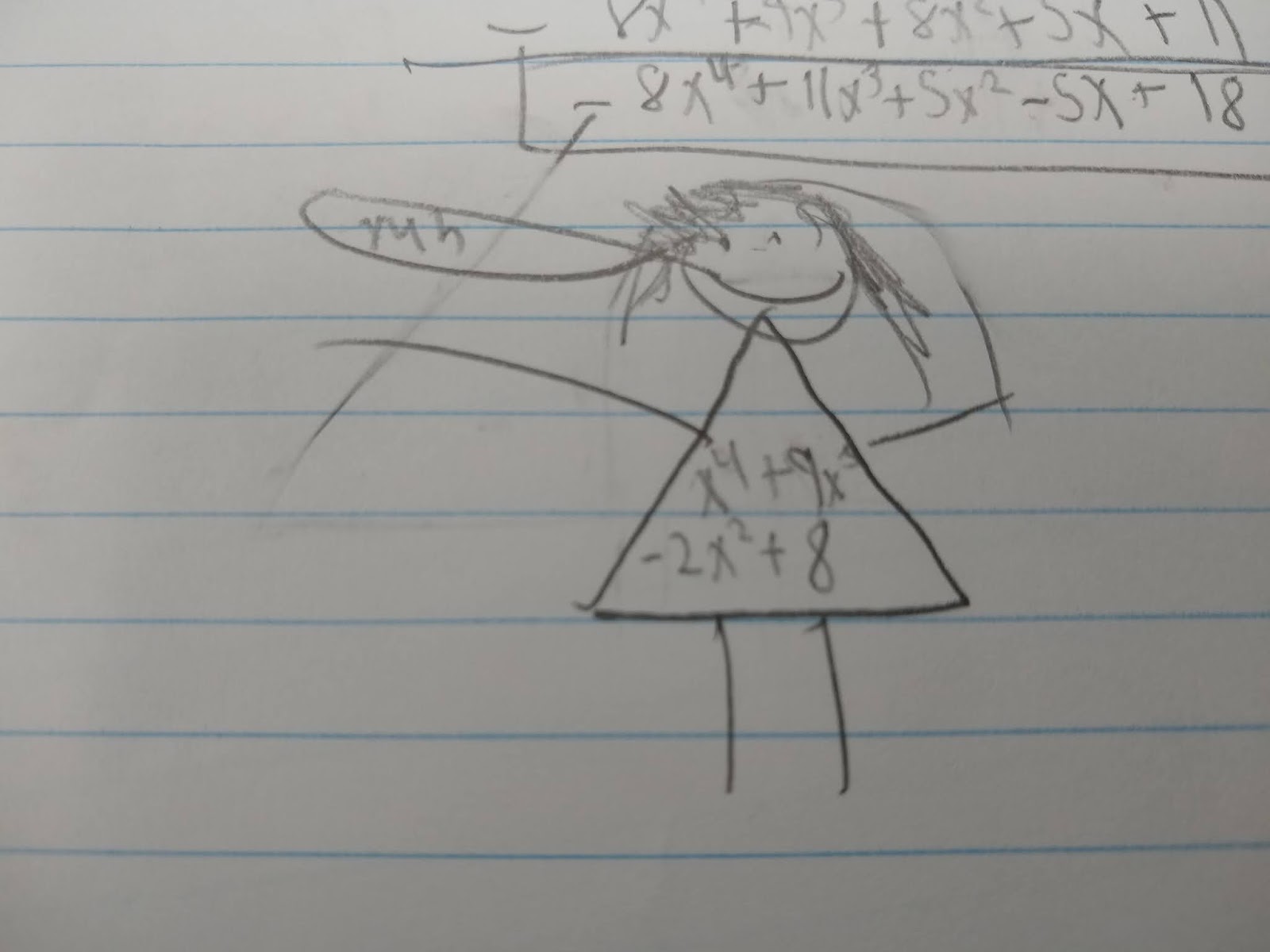
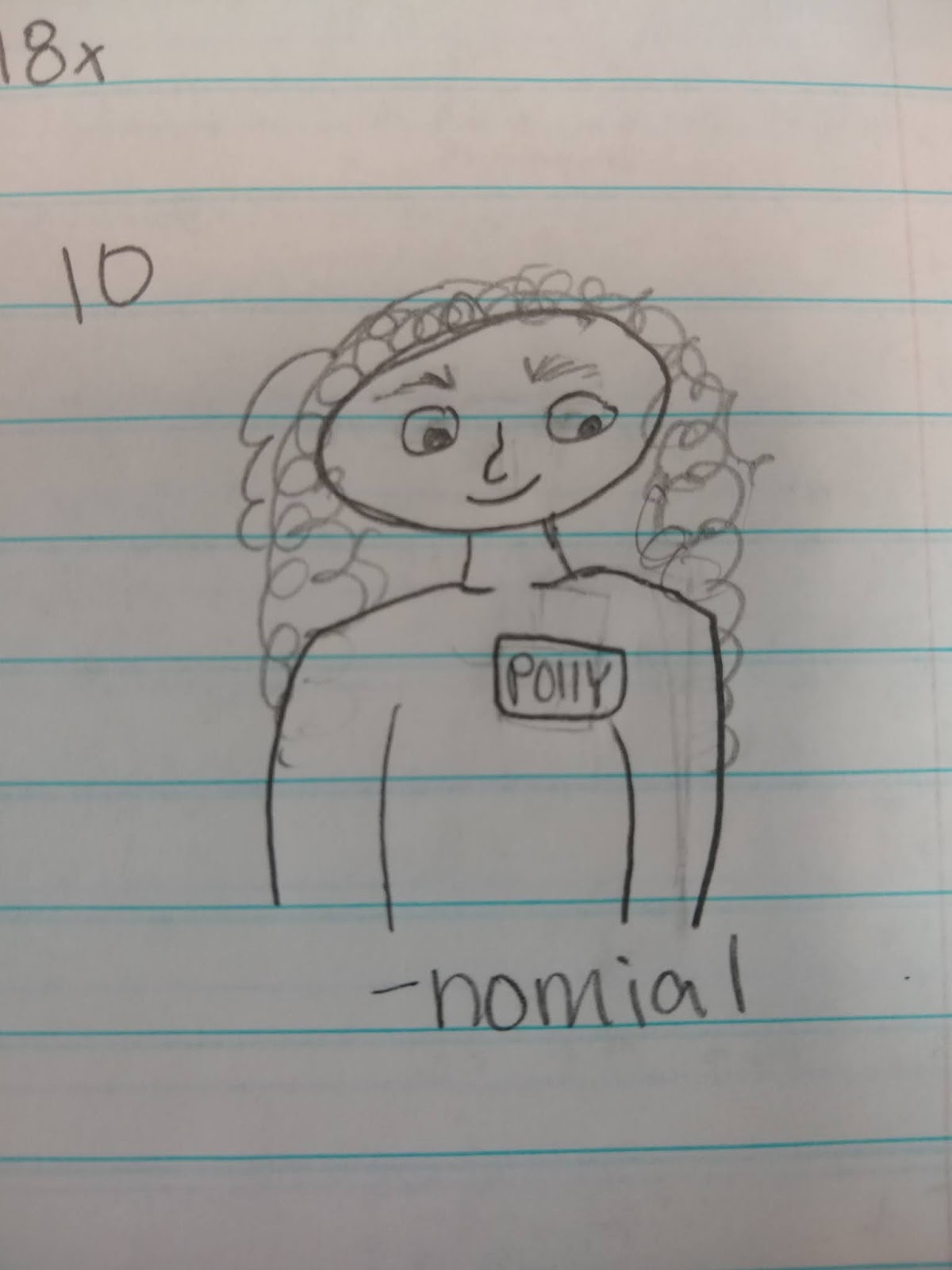
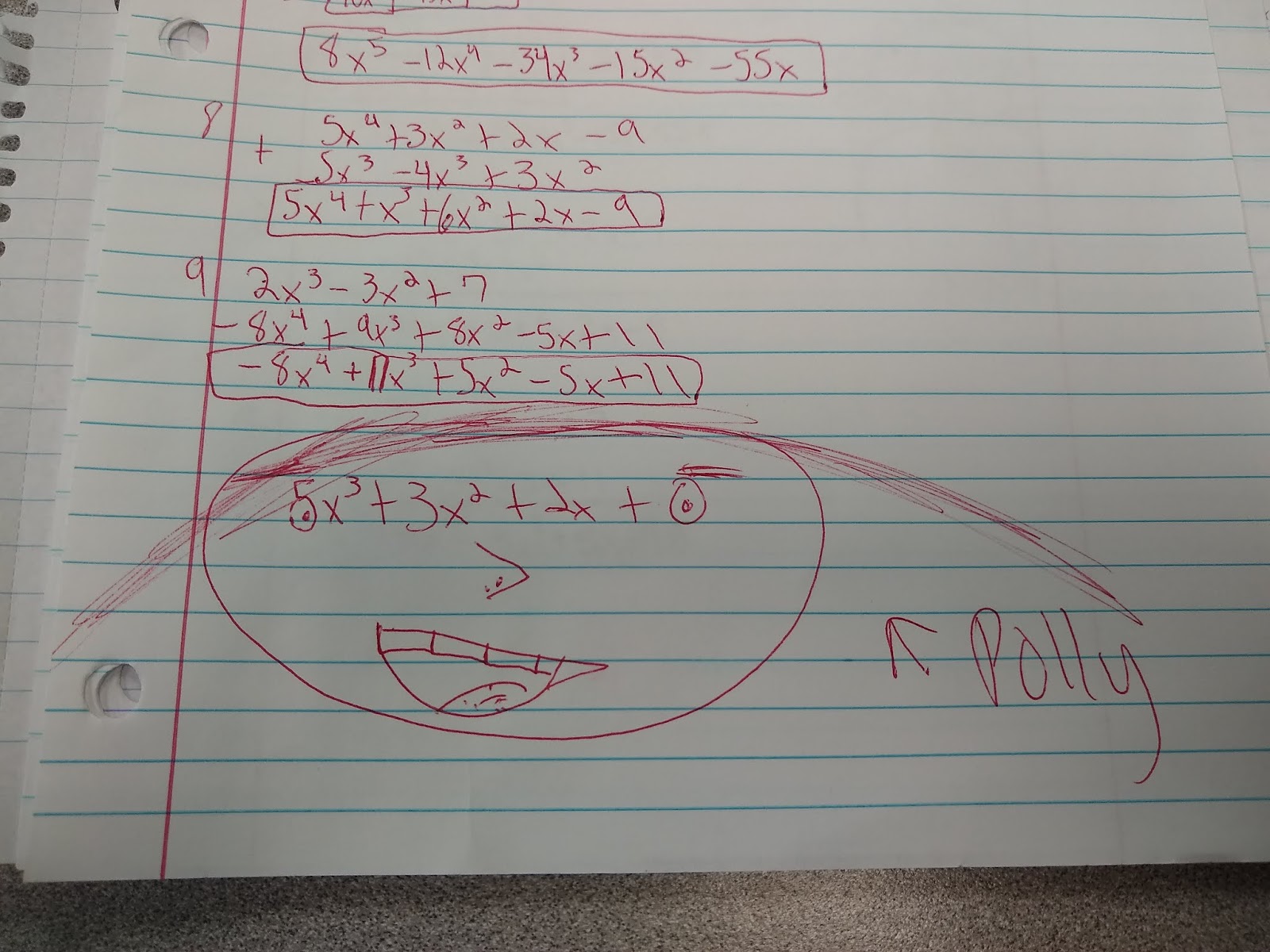
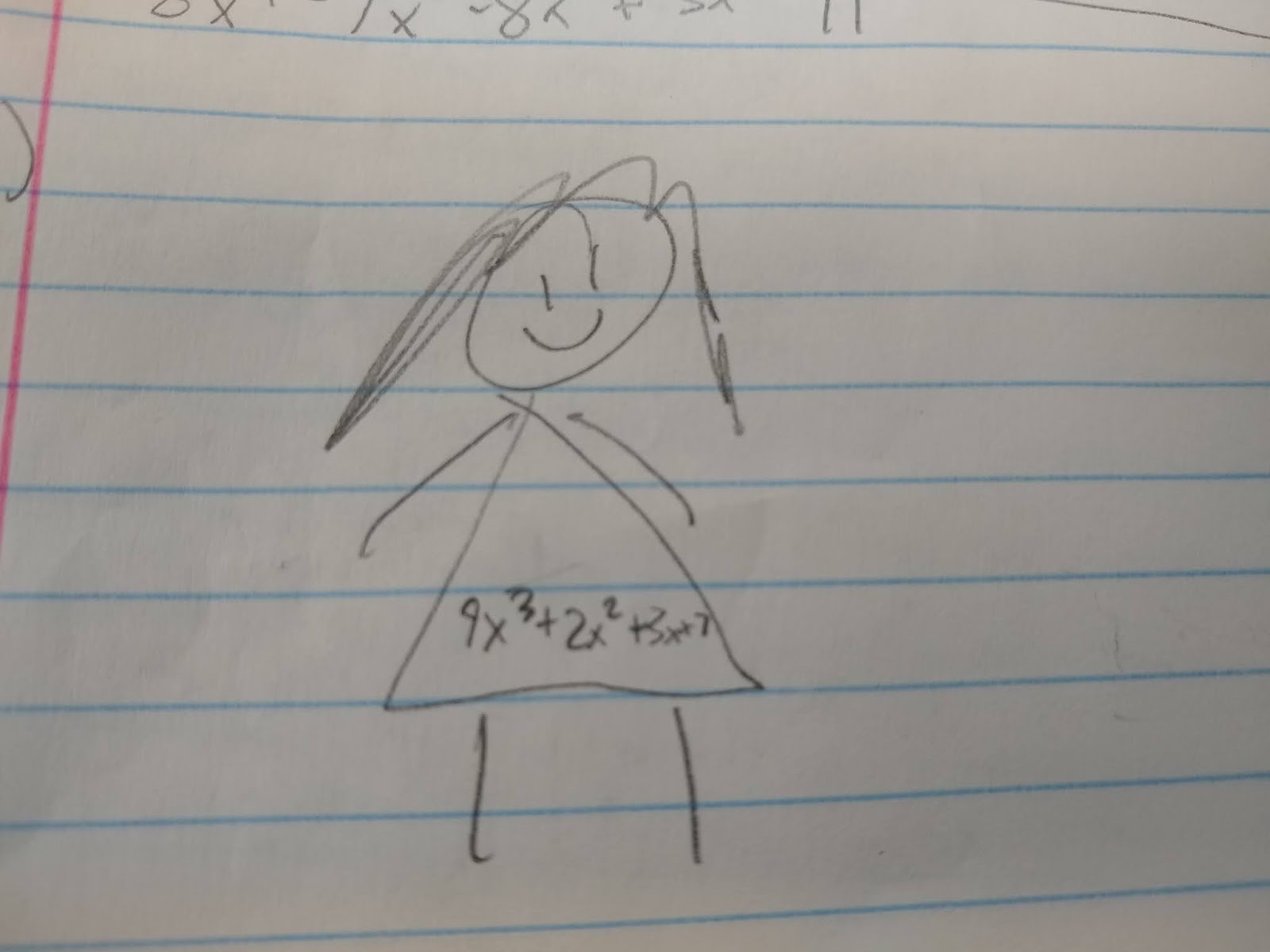

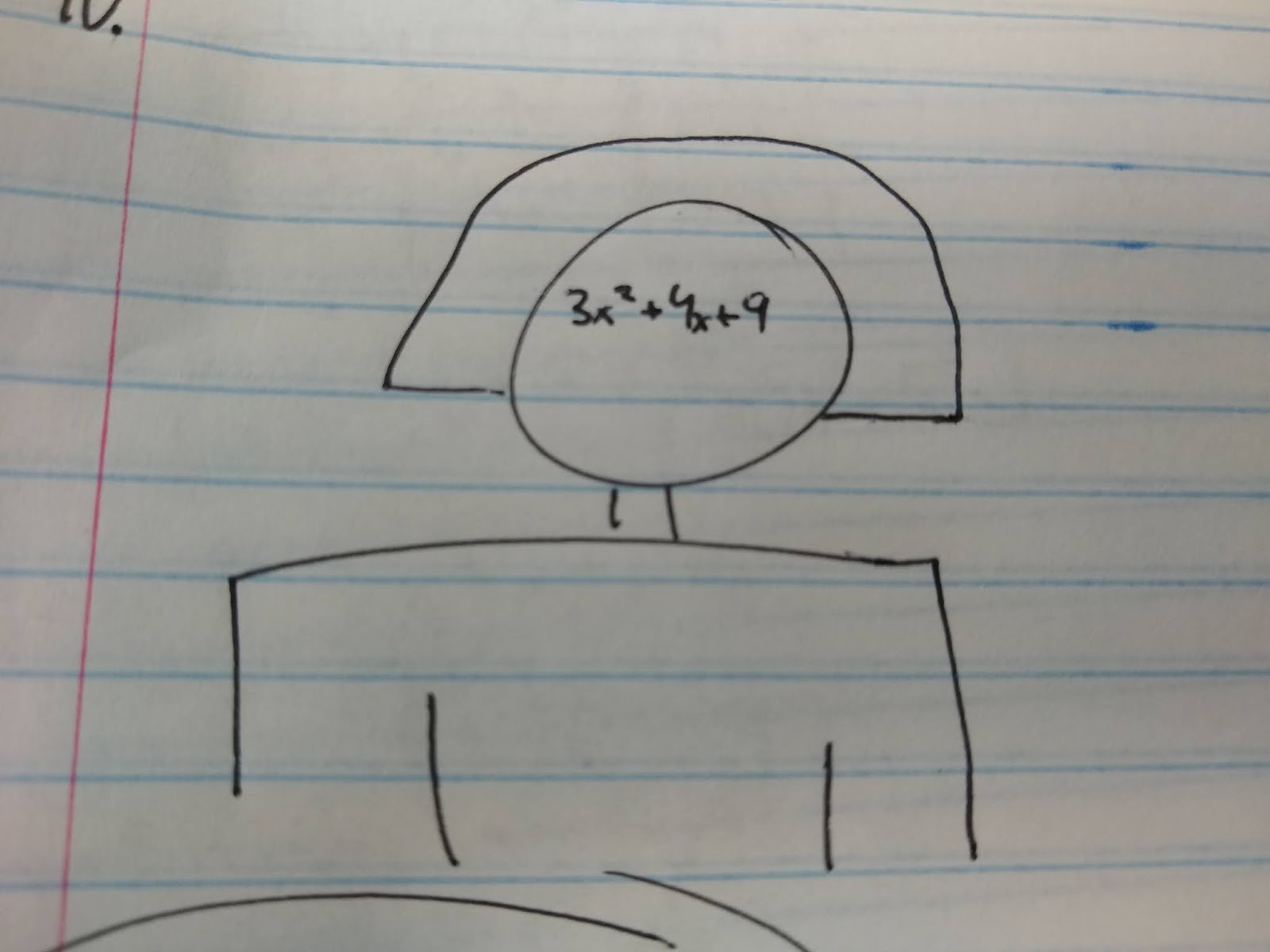
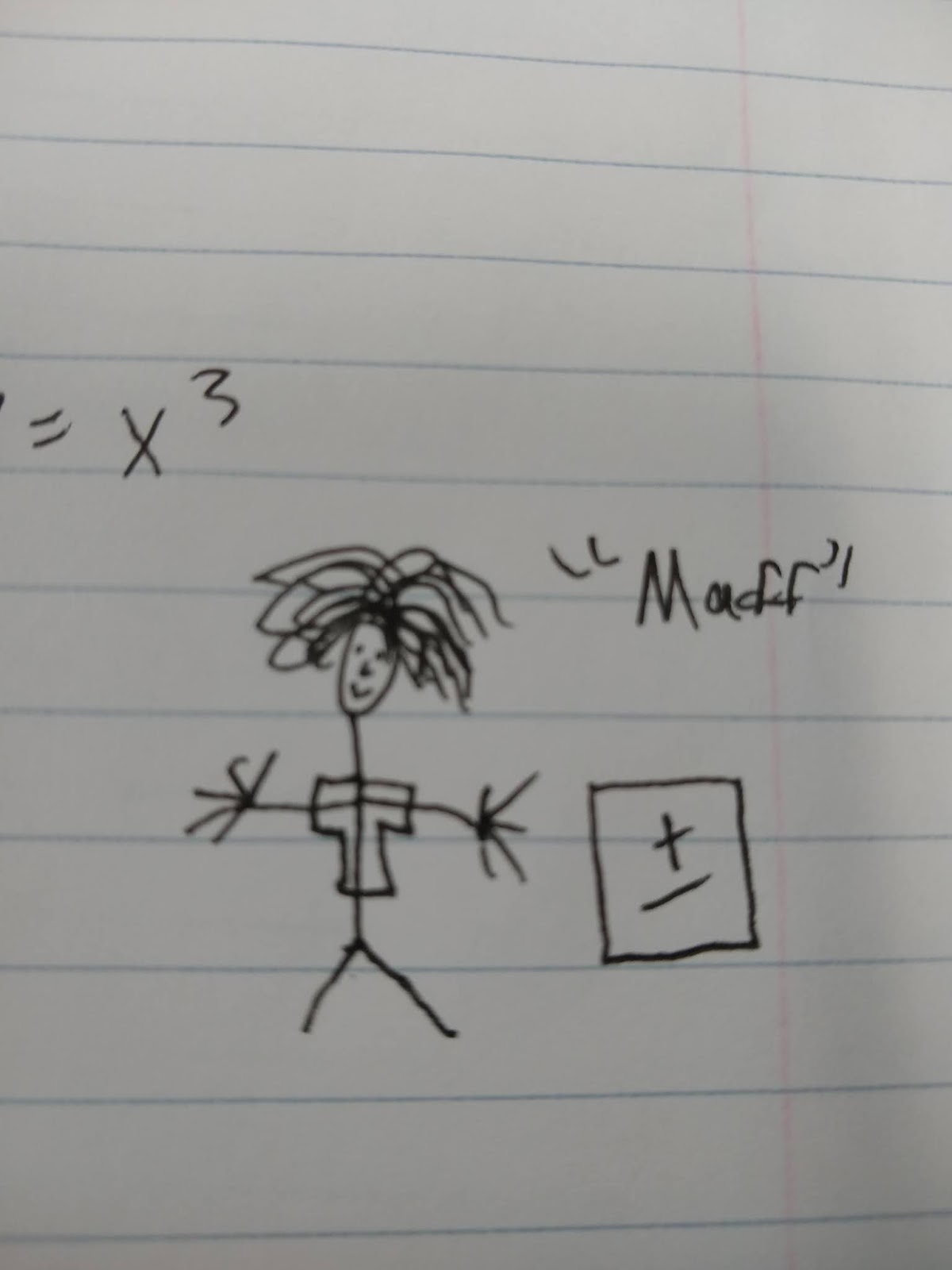

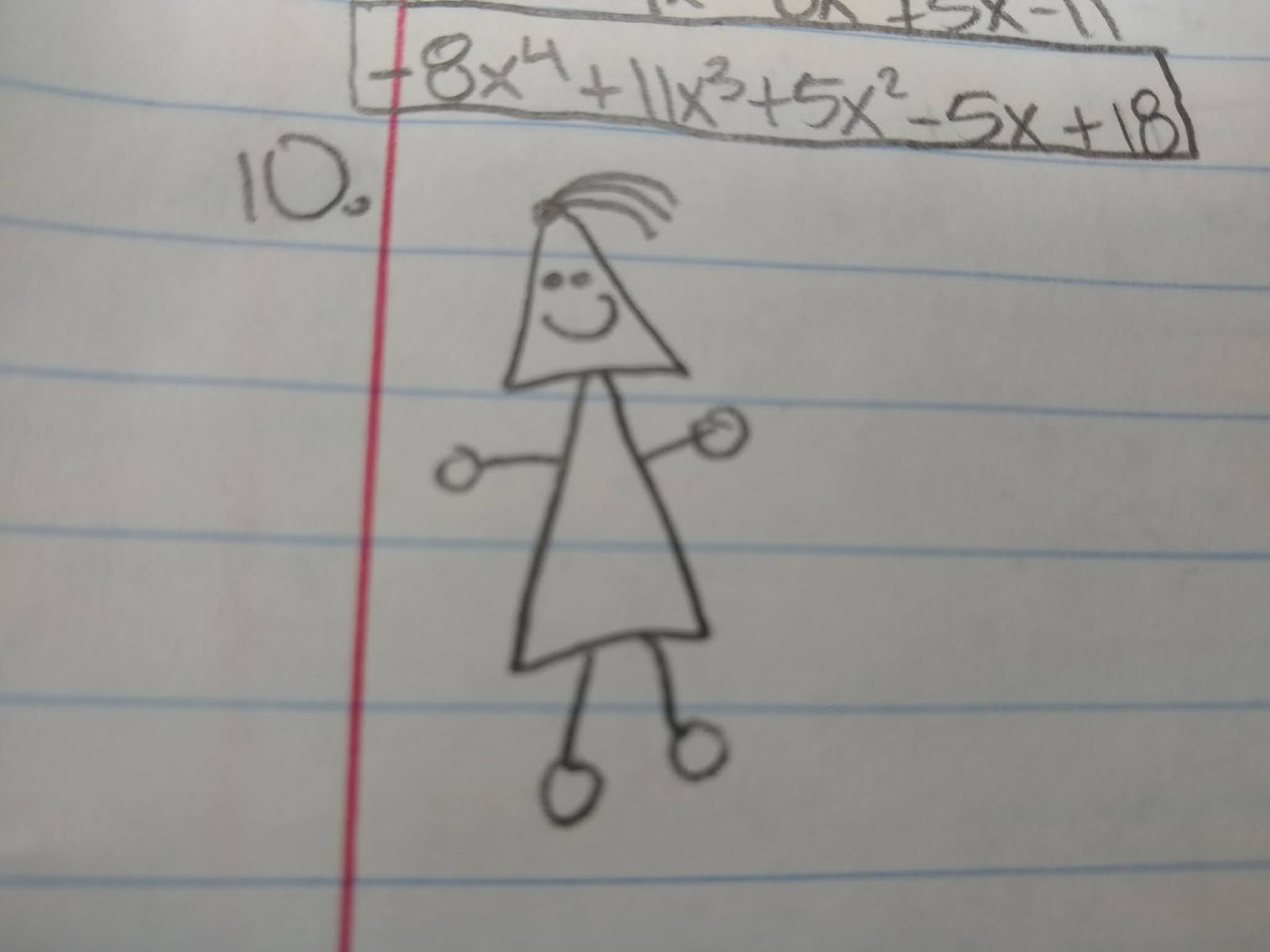
May 19, 2020 – Prepping for Pi Day
You may be thinking to yourself that I’ve lost it. It’s May. Why in the world is Sarah posting about Pi Day?!? Well, this post has been on my to do list since late February. And, then you guys all know what happened in March. The world went crazy.
The last day I saw my students in person was March 12th. And, Pi Day was the last thing on my mind. Instead, we spent the day speculating about this COVID-19 virus that the news couldn’t stop talking about. We talked about upcoming travel plans that may or may not happen. We discussed when we might see each other again if school did have to shut down. I think a lot of us were kinda excited about the prospect of a two or three week Spring Break.
Oh how wrong we were. We didn’t know just how much the world was going to change. I remember realizing how it was the least celebrated Pi Day I had ever seen in all my years of being on Twitter. All this time of self-isolation has given me time to go back through my to-blog-about list and make some stuff actually happen.
I’ve already decided that if I get to, I’m going to go all out for Pi Day 2021. So I’m publishing this post now so it’s ready to go for next March. Much like my Math-y Christmas Ideas post, this post is a compilation of Pi Day ideas that have already been shared in various volumes of Monday Must Reads. I’ve put all the Pi Day posts together in one spot so you can see all your options for celebrating this mathematical holiday.
So, if you’re a devout follower of this blog and read each and every post, there’s nothing new here. Sorry. But, there’s probably a post or two that you’ve forgotten. I know I had, and I wrote every single one of these blurbs!
Enjoy!
Pi Day Ideas for Math Class
I am a fan of this calculus-based pi day graphing project that Alisa shared.
RupeleMx challenged his students in Mexico with the Square Pi Puzzle. I love how he also captured the other figures they ended up creating.

Mrs. Richardson shares a great pi day idea – a poster contest.
Vicki Biarnesen shares a yummy non-pie treat for Pi Day.
Vincent Pantaloni shares a fun fact to share on Pi Day.
Megan Geltner inspires with a Pi Passport idea. Perfect if you’re already thinking about how to celebrate the next Pi Day!
Becca Phillips shares an awesome t-shirt idea from her daughter. Sadly, 2020 doesn’t appear until 7000 digits into pi…
Yet another pi day idea from PGCPS Secondary Math to file away for next year! Great idea for decorating with some pi day coloring sheets.
Cheryl Tavernelli shares a winning entry in a Pi Day Character Contest. What would your students come up with?
And, check out this awesome photo day opportunity for Pi Day!
I must share this mathematician dress-up contest idea from Renita Bushell for Pi Day. Can you guess the mathematicians?
Mary Platt shares a great water-color based pi day lesson.
I love Becky Roloff‘s idea of having a coloring contest.
I love this finding pi activity from Annette Williams.
I love Ms. R‘s idea of making pi necklaces.
Laura Frcka shares a new-to-me idea: pin the radius on the circle.
I’m super inspired by how Priscilla arranged her desks for Pi Day!
Sabrina Grasso shares a brilliant use for a hula hoop while celebrating Pi Day.
I’ve seen skylines made of pi before, but Sarah Gyimoty takes it a step further with the first 180 digits of pi!
I am amazed at Lisa Rode‘s creativity in creating these pi related trophies.
Already thinking about next year’s celebration? Make it a school wide celebration with this idea from Pep Anton Vieta.
I also love this colorful pi display from Jae Ess!
Check out this awesome pi themed WODB from Zach Armstrong.
Texas Math Teacher shares a fun twist on Tenzi (one of my favorite dice games ever!) involving dice and pi.
Check out this awesome Pi Day Dingbats challenge from Ms. O’Donnell Maths.
Jacqueline Tishler shares the idea of engaging students with a kahoot on pi facts.
Mariel Mates wants to encourage crafty math teachers to knit or crochet their own scarf that has rows of colors corresponding to the digits of pi.
Here’s a Pi Sudoku Puzzle shared by Cliff Pickover.
Denis Sheeran shares another idea for celebrating that involves a circle drawing contest. Check out all the details here.
Wendy Sargent shares some ideas for celebrating.
Mr. Downin shares a creative idea: hide pi symbols around the school for your students to find!
Elizabeth Raskin engaged her students in a very visual discovery of pi. I’ve seen a lot of pi-related activities, but this one was completely new to me.
When the world returns to normal again, I think I want to try to do a Pi Day Bake Off Competition. Thanks to Westie’s Workshop for the idea!
Have other great ideas? Leave them in the comments!
May 24, 2020 – 5 New Things I Tried in my Classroom this Year
Every year I try what feels like a million new things in my classroom. Some are life changing. Others are just meh. I end up doing them one year and decide they weren’t worth the effort/upkeep. Part of the problem of having a blog is that I often blog about all these ideas before I really know if they are classroom gamechangers or stupid ideas that turn out to be very impractical in the classroom. I frequently receive blog comments asking about something I blogged about during my first year of teaching that I haven’t done since….well…my first year of teaching. I don’t really know how to respond to these comments because this idea that the person is so excited about is to me a dud.
As I reflect back on this very weird school year, it got me thinking about which of the new ideas I tried that were worth keeping. So, I present to you: 5 New Things I Tried This Year (and am still excited about!)
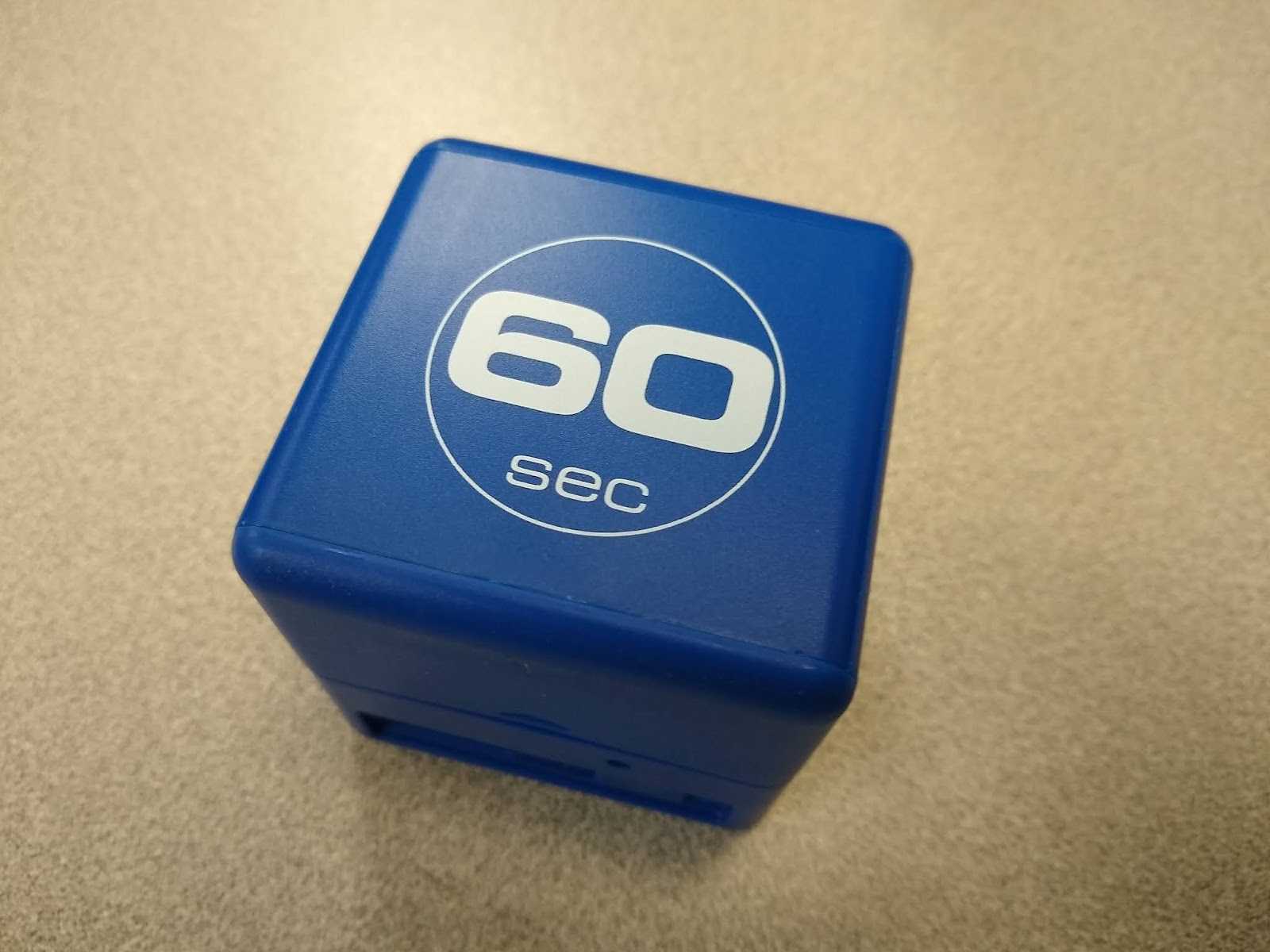
One of my most-used new classroom tools this year was a cube timer. So, how does it work? Flip the cube so that the time facing up is the amount of time that you would like to set a timer for. A timer will automatically start. When the timer goes off, just flip the cube so the blank side is facing up again.
I did ACT practice as daily bellwork this year (something I definitely still need to blog about). On the ACT, students are given 60 minutes to complete 60 math problems. So I wanted to give my students practice trying to spend no more than 60 seconds on each day’s bellwork. It was so easy to flip the timer cube at the beginning of each hour. I know I was way more consistent in timing my students this way than if I had tried to use my cell phone timer. Fun Fact: the cube timer I purchased was marketed towards people doing high intensity workouts. Ha ha ha. That’s definitely not me.
2. MATH JOKE OF THE WEEK

My students LOVED the math joke of the week that I added to my classroom this year. Students would tell me how much they looked forward to coming into class on Mondays because it meant seeing a new joke. One student would wait for students to come into class, force them to read the math joke of the week, and then raise the flap with great fanfare. Still others would remind me when I had forgotten to change the joke out that week. Whenever they did this, I would give them the binder full of jokes (all of them already in sheet protectors to make the switch-out easy) and let them pick the next week’s joke. This felt like such a privilege. They would flip through the jokes, laughing at each one, until they found the perfect joke.
This will definitely be an ongoing thing in my classroom going forward.
3. CUSTOM LESSON PLAN BOOK
My mom found a book binding machine at a thrift store about two years ago that I currently have borrowed. I used it this past summer to create a custom lesson plan book. It was completely worth the time and effort I put into making it if you ignore the fact that I only got to use 3/4 of the pages due to school shutting down for COVID-19.

The year before this past year, I used a planner I picked up at Big Lots as a lesson planner. It worked, but I got tired of writing in my subject names at the beginning of each week.

Last summer rolled around, and I decided I could make my own and have the subjects written in for the entire year. On top of that, I could customize it for our school calendar and mark out the days that we were out of school or had professional development.


As the year progresses, I highlight hands-on/minds-on activities in yellow. This helps me to keep my pulse on when I’ve gotten into a rut of just doing notes/homework/repeat. I highlight all my assessments in blue.

When I showed my principal my lesson plan book during my last observation, he was surprised that it was only filled in up to the current day. I guess this is more of a lesson record book than a lesson planning book. My planning tends to occur on notebook paper and a ton of post-it notes. I use this book as a reference of what we did each day so that when a student comes and says they haven’t been here in two weeks, I can figure out exactly what they missed.
4. BOUND COPY OF OKLAHOMA MATH STANDARDS

Another thing I’m really glad I did this past year was use the binding machine to create a bound copy of the Oklahoma Academic Standards for Math. This was most useful when I found myself in meetings. It was so handy to be able to actually pull out the standards when questions came up instead of just talking about what we thought was in the standards.

I recently closed out my classroom for the summer, and I made sure that I brought home my printed/bound standards book. I’d recommend creating a nice printed copy of your standards to every classroom teacher who hasn’t already done so.

5. WEEKLY AGENDA BOARD

I know that there is nothing new at all about this idea. But somehow it took 8 years of teaching to finally get around to creating a Weekly Agenda.

My students did regularly reference the board, and it will definitely be something I continue to keep doing in the future. I think I’ll be making magnets for things such as Quiz Days, Notebook Checks, etc. on bright colorful paper so that they stand out more on the Agenda.

July 24, 2020 – Life Lately…
Hi there, strangers. It feels like it’s been FOREVER. Life has been a bit on the crazy side, and it seems like blogging is the first thing to go when life loses a sense of normalcy. And, we all know that life hasn’t been normal for quite some time now.

So, other than the fact that we’re in the midst of a worldwide pandemic, what’s been making life so crazy? It’s a long story, and it all starts with cake. I present to you the world’s most expensive birthday cake.

When my husband requested sponge cake with jam and whipped cream for his birthday, I was happy to oblige. I love baking, and I was excited to try a new recipe. Instead of turning into the highlight of the day, the cake led to the worst birthday ever after I managed to break my finger after getting it a bit too close to the beaters on the hand mixer. Nothing quite says happy birthday like having to finish assembling and decorating your own birthday cake because your wife has broken her finger…

It was the type of accident that shouldn’t have been a big deal. I felt so silly. How does a person break a bone making a birthday cake? A trip to urgent care the next day showed that my finger wasn’t just broken. The bone was shattered. A visit to the orthopedic surgeon revealed that I had not only a broken finger requiring surgery but also an enchondroma, a (most likely) benign bone tumor. The bone tumor had been eating away at my bone and had weakened it so much that the incident with the beaters that should probably have just left me with a bad bruise had left me with a shattered finger. The nurse practitioner told me during my follow-up that my bone had turned to jelly where the tumor was. Gross…

And, that’s the story of how I ended up getting to experience not only my first broken bone but also my first surgery and first experience with anesthesia. Surgery went well, but the recovery was rougher than I expected with some weird side effects that lingered a few more days than I expected. I had to have a pin placed in my finger to stabilize all the tiny bone fragments. This wasn’t too bad in and of itself. What was really inconvenient was being told by my doctor that I wasn’t allowed to spend any time outside for the next month. Under no circumstances could I do anything where there was the risk of getting sweaty. This is not the thing you want to hear in June in Oklahoma.

I owe a great amount of thanks to my super amazing husband who stepped up and did all the diaper changes, all the bath times, and all the toddler outfit changes for an entire month while I was pretty useless with my arm in a cast. Three splints, one surgery, and two casts later, life is now starting to return to normal. I’m currently in hand therapy twice a week. I kinda underestimated just how hard it would be to move my finger following surgery and a month of not moving inside of a cast. It’s been interesting to see the various ways that math pops up in physical therapy. For example, at my first therapy appointment, they measured the amount of movement in my ring finger at 30 degrees. A week later, I had improved that number to 80 degrees. I’m always telling my students how much math is in the real world, but I sometimes forget what that actually looks like myself since the math I encounter on a daily basis is much more of a traditional textbook nature. Now that school is starting back soon, you can plan on seeing me around much more on this blog and twitter. In my district, teachers return August 6th and students on August 12th. Here’s to starting the craziest year yet of my teaching career. Hopefully it won’t involve any more broken bones…

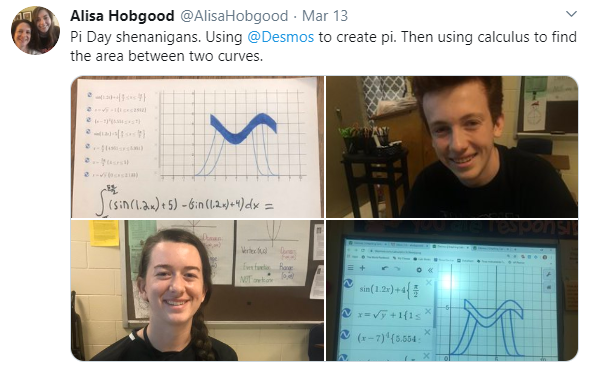
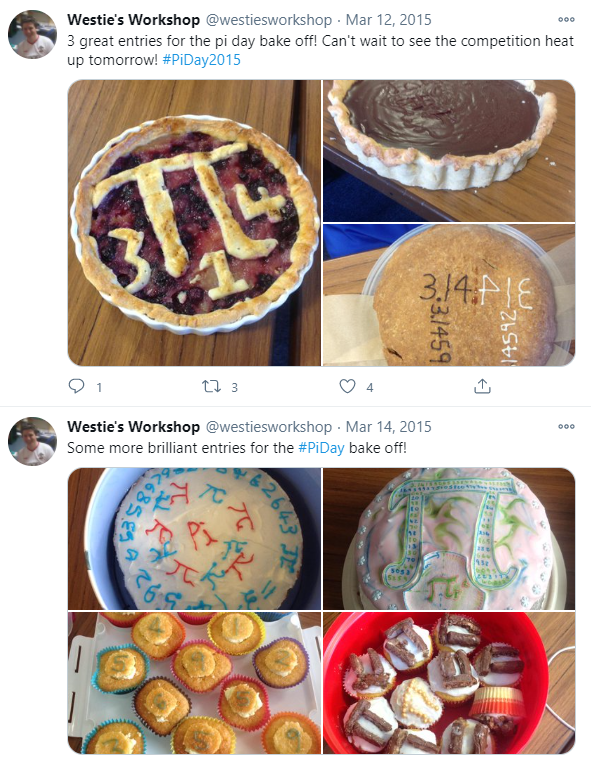
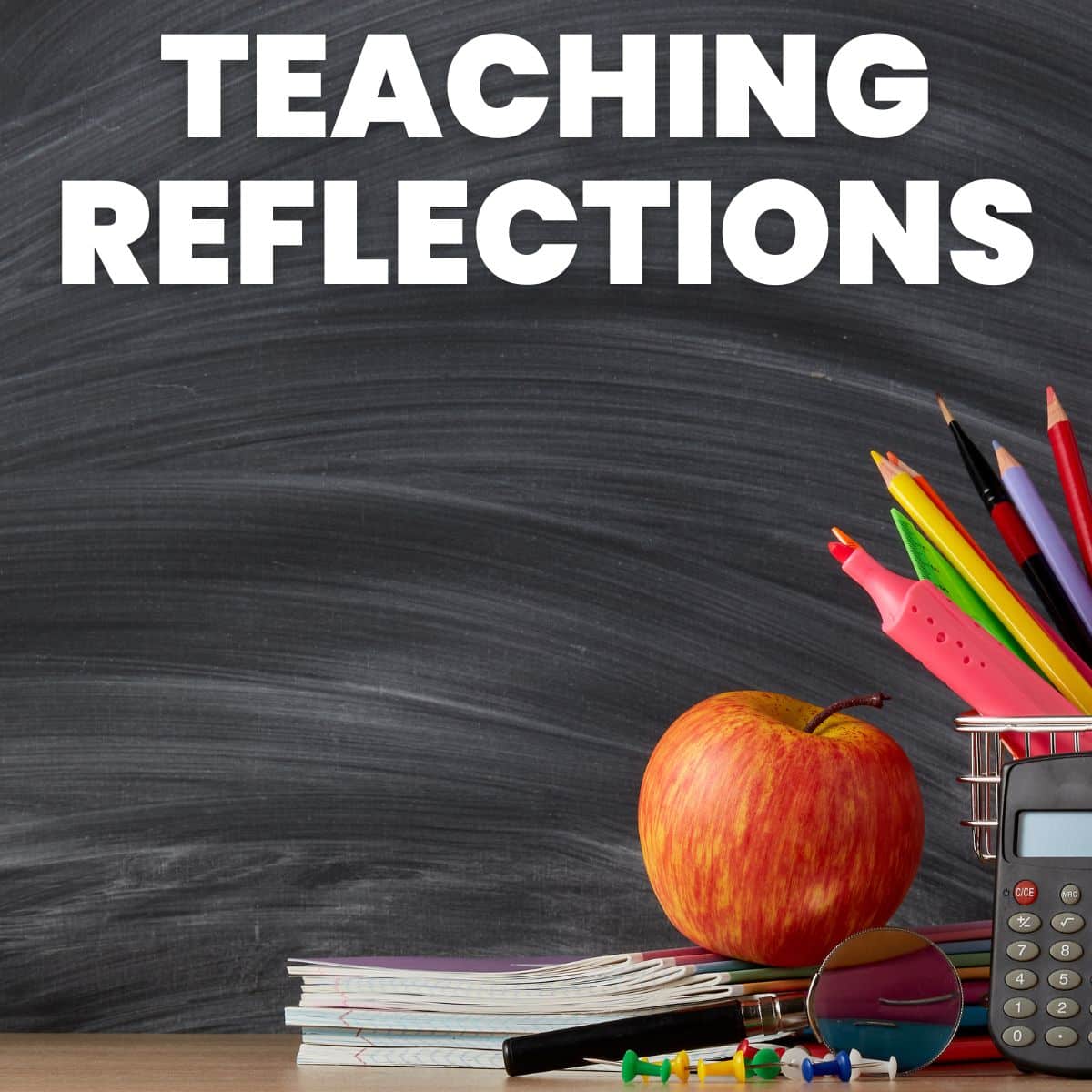
How did you create the lesson plan book? What software did you use?
I made it using Publisher.